
The well named "avenger", Juggernaut of retribution
The Grumman TBF Avenger is the well-remembered, massive WW2 US Navy torpedo bomber of the USN. It was also at the time the largest and heaviest single-engine aircraft of the war. It forged an enviable reputation as the main stick of the fleet carrier force in 1942-45, insturmental in the Pacific Campaign. Developed quickly and adopted as fast by the USN, it never suffered the comparison with the ill-fated SBC Helldiver and was beloved by its pilot, although slow and ponderous.Extremely rugged, this behemoth of a plane replaced with success the previous Douglas Devastator as planned, with flying colors, despite sufferinf the comparison with more advanced Japanese equivalents at the time. Coupled with the Hellcat or Wildcat on escort carriers, the war-winning design earned the nickname of "tough turkey". The Avenger shared credit for sinking the Yamato and Musashi, the cruiser Mogami, five aircraft carriers, many destroyers and 30 axis submarines. Greatly modified after the war, the Avenger still performed until the 1960s as an ASW patroller, well-exported. A legendary design, deserving a comprehensive study.
A replacement for the Devastator

TBF Avenger, mid 1942
With the Vindicator, the Devastator was the main USN torpedo bomber in service on carriers of the USN until after the battle of Midway in June 1942. Developed to replaced the TBD-1, already obsolescent in 1939 the Avenger was larger, with an engine almost twice as powerful and giving a bomb bay to use an improved aerial torpedo or bombs (1,500 kg). It proved also invaluable for reconnaissance with a camera and flares, and could do precisision bombing. It was one of the best aircraft of the American air fleet, extremely rugged, powerful, reasonably protected against gunfire, and well defended by a turret and belly MG gunner, it was also superbly resilient, a perfect complement of the equally rugged F6F Hellcat of the same manufacturer. The prototype first flew in 7 August 1941. It was introduced gradually in 1942 and replaced all older models (but not the Dauntless) at the end of 1942. It became the bedrock of the Essex class aircraft carriers as well.
Design development
The TBF Avenger emerged from the 1939 US Navy requirement to replace the Douglas TBD Devastator, which was in service from 1937 which advanced tech for the time, but now no longer relevant. It was indeed obsolete when the attack on Pearl Harbor comenced and was withdrawn in the months following, in 1942, then completely retired by 1944. In between, back in 1939, the USN determine the powerplant was the paramount factor for a replacement design and wanted the best and latest engine from Pratt & Whitney and Wright.The requirement called for:
-A crew of three,
-A top speed of 480 KPH (300 MPH),
-A warload of one 900 kgs (2,000-pound) torpedo, or three 225 kgs (500-pound) bombs
-Internal bomb bay,
-Armor protection for the pilot and gunner,
-Self-sealing fuel tanks,
-Powered dorsal turret.
The finalists were Vought and Grumman. Vought delivered the XTBU-1 prototype, two being purchased and evaluated as well as two XTBF-1 Grumman prototypes. For the well-known company until then accustomed to lighter models, fighters, this was a daring first foray into heavy duty carrier planes. For this proposal, Leroy Grumman started from a blank page, just making a larger model, a conventional monoplane which could accomodate a large crew, all-metal. The whole project was elaborated in just five weeks, under the direction of chief engineer Bob Hall. Another "first" for Grumman was the design of an internal bomb/torpedo bay to help in aerodynamics qualities, while integrated a belly gunner. This was the task of Robert Koch. Former designer at General Electric, Oscar Olsen developed the electrically-powered dorsal turret. It invented notably for it the "Amplidyne" control able to cope with violent loads transfers in flight maneuvers; And the whole design made the turret lightning fast.
The final result was not appealing though, if rational, gaining in the company the nicknames of "Turkey" and "Pregnant Beast" or later "Chuff". The final design incorporated a forward-firing 0.3-in M1919A4 placed on the right side of the nose and operated by the pilot but also the belly gunner 0.3-in Browning MG used by the bombardier when not on its task, and the main dorsal defensive 0.5-in heavy machine gun in the dorsal powered turret, which was the plane's main rear protection.
Competition
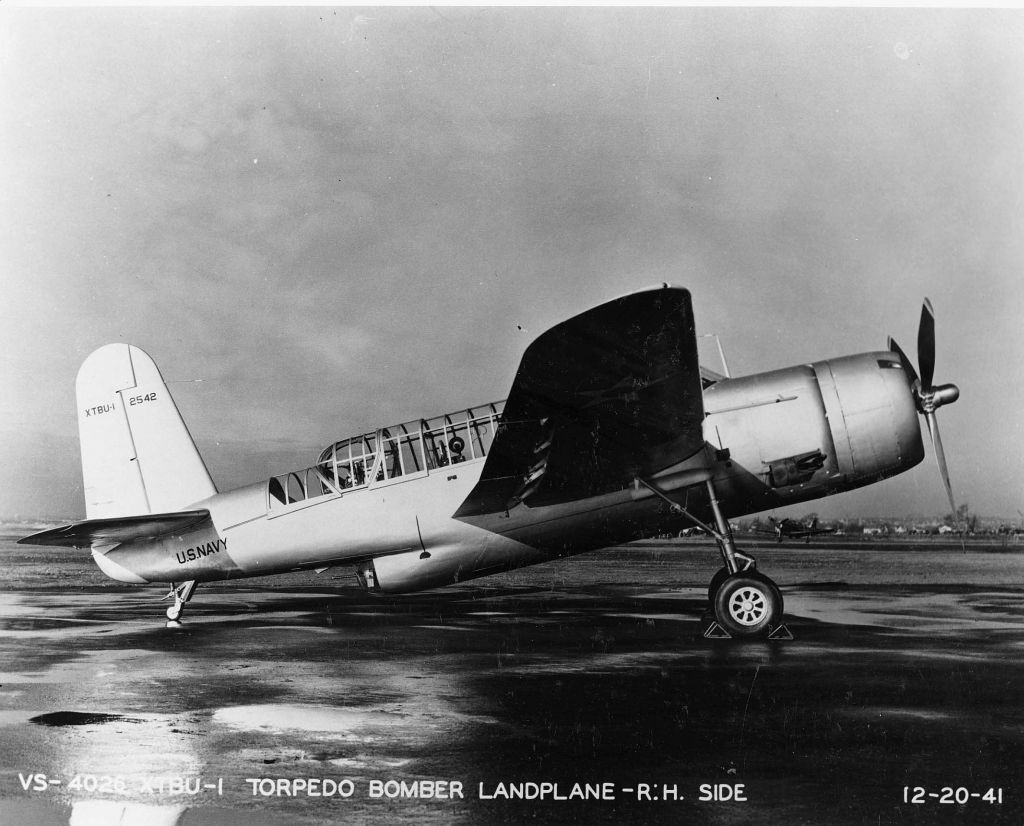 Vought's competitor XTBU-1 was good, but it's development lingered between April 1940 to December 1941. By then it was too late for a production.
Vought's competitor XTBU-1 was good, but it's development lingered between April 1940 to December 1941. By then it was too late for a production.The US Navy looked at the Grumman design, despite the competition was good, as the Vought XTBU-1 was even more promising with some advanced tech, notably to facilitate the pilot's work. However the latter had many issues due in part to its complexity and was not ready when the Navy needed it. Moreover, the company was already struggling to fulfil orders for the F4U Corsair and could not give any date for a production start. That was the main issue there.
The Avenger was chosen by default, and a reorganization assigned the TBY project to Consolidated. The latter was not in a hurry to complete it, and the project evolved as a potential replacement for the Avenger, the Navy adding now requirements and modifications. The programme lingered up to such a point the final TBY Seawolf ended with only 181 built in 1944-45 before being cancelled.
Grumman being the earliest, and with the most promising rapid development was declared the winner wit an order placed by the USN for 286 aircraft, on April 8th, 1940 before the prototype had even flown. This was done in August 1st, 1941. The XTBF-1 had its maiden flight piloted by engineer Bob Hall, equipped at the time with the Wright R-2600-8 14-cylinder Cyclone radial, just completed, capable of 1,700 horsepower. This info was passed to the Navy which was reassured in its risky bet. The need was so pressing for a reliable production machine that the USN confirmed the order but the initial procurement was later modified to appear more conventional and open. However the flight was not perfect. Bob Hall reported the aircraft suffered badly from yaw instability, and the flight was somewhat hair-raising... Many fixes were made, including a tail-dorsal fin on the second prototype, absent on the first (see later). Also the prototype failed to meet the top speed, being about 10% less than Navy spec, although performing well in all others.
Development of the prototypes went on. On November 28th, 1941 one XTBF-1 crashed, but fortunately Bob Hall and Gordon Israel had parachutes. Later the investigation nailed the electrical wiring, which caused a fire in the bomb bay. The remainder XTBF-1 prototype completed all its test flights, helping ironing out all located defaults, until the pre-production models would be manufactured. Notably, the production model's tailfin featured a sizeable fin fillet to correct the yaw instability problem. The opening ceremony of the company new facility coincided with the very day of the Japanese attack, famously. The TBF was later officially accepted by the navy, with the Grumman's code.
Design of the Grumman TBF Avenger
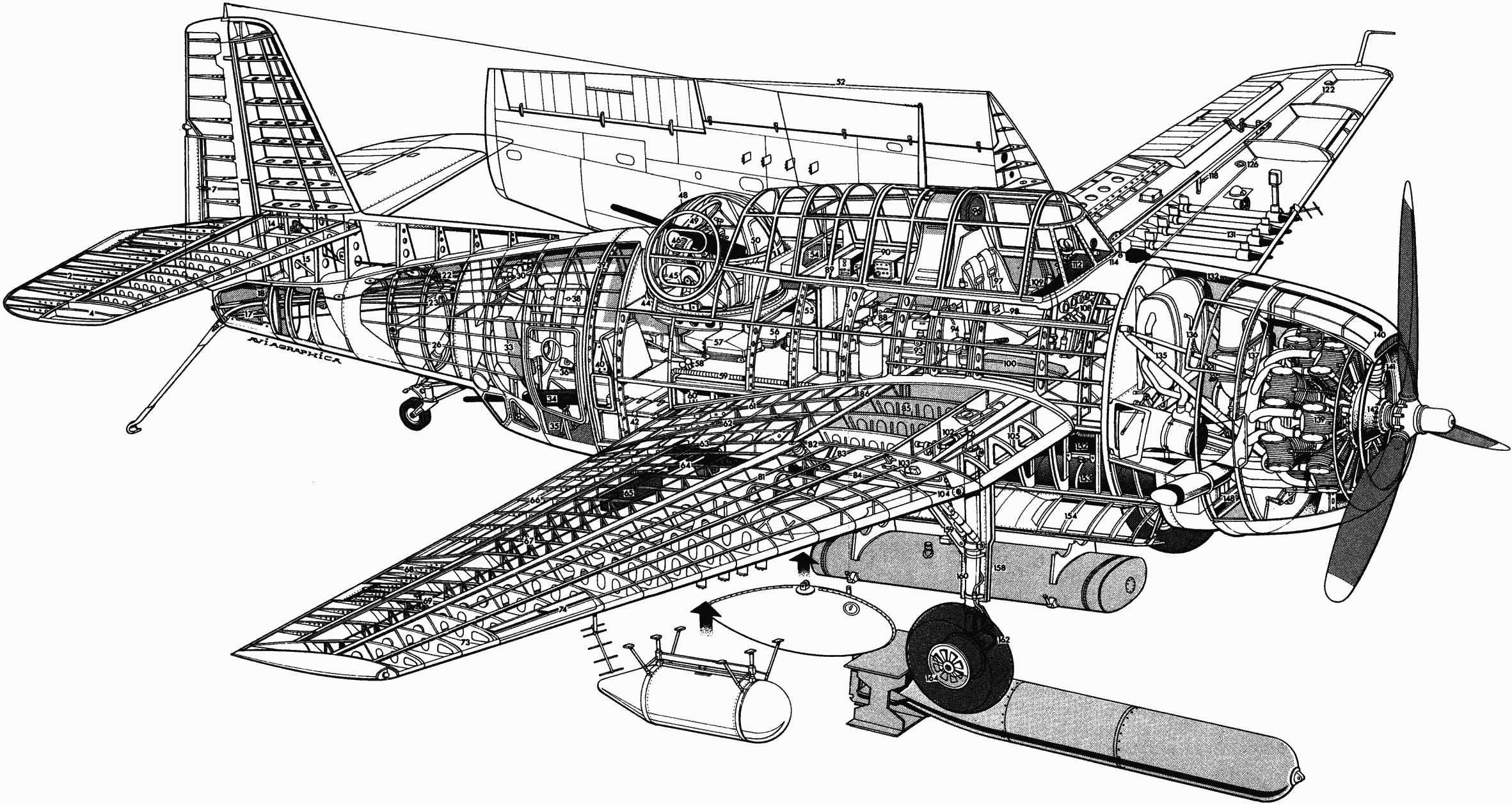
A bit like the Hellcat, the TBF looked brutish. It was not to win any beauty contests, but became perhaps one of the best torpedo bombers of the second world war, with the unassuming Swordfish and Italian Sparviero as perhaps equals in reputation. Like the Hellcat again, it had its very large engine and a bulky fuselage to accomodate both a belly gunner and large bomb bay, and procure good visibility to the pilot. It had a tremendous reliability and resilience, combined with enough adaptability and modularity to perform a large panel of missions over the years, explaining it largely out-did its potential successors, but the Douglas AD.
The Design the Grumman team choose for such short notice was conventional. The team embarking on a brand new type did not wanted to add many innovations on top of this. It just stuck to comply with the requirements. The TBF Avenger notably had wide-area wings, in fact the largest span of any USN plane in service for many years. It was also the largest and heaviest single engine model ever deployed on a an aircraft carrier, in any navy to that point. The stout fuselage had an oval section, semi-monocoque construction with stressed duralumin skin.
Fuselage design
The forward cowling barely housed the massive and powerful radial engine coupled with a classic Hamilton three-bladed propeller (see later). The cockpit, like for the Hellcat, was voluntarily placed high atop the deep fuselage for better visibility, but this contributed to the bulky appearance, in stark contrast with the nimble Vought XTBU-1. The typical "greenhouse" could all three crewmembers, and covered about 1/3 of the fuselage lenght. There were seated position for three crewmen seated inline: The pilot forward, the bombardier/belly gunner/navigator, and the rear turret gunner (see later for details). The lower fuselage had aft vision ports for the bombardier while housing additional equipment, lifeboat, flares, survival gear. Production models differed by the frame numbers, especially for the pilot's canopy, sometimes divided, or deleted frames.Wings, tail, landing gear, hook
Controls: The distinct empennage to the rear had a bump and the tail section on top, the latter being of conventional layout. Like previous Grumman models, wings, tail and rudders were all squarish. The main wing assembly was mounted in a low-mid position, straight with some dihedral past the landing gear.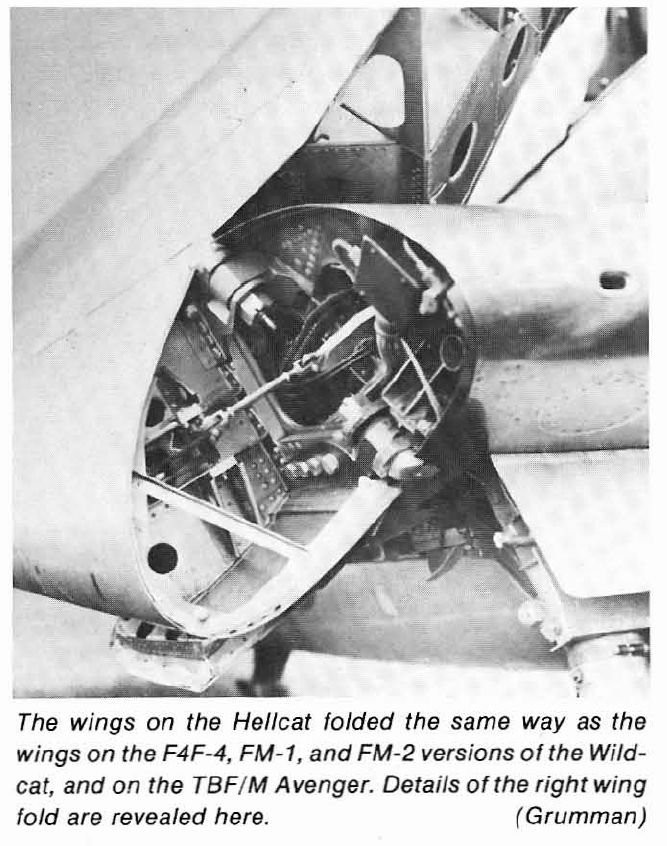
Sto-Wing folding axle seen in detail on the F6F Hellcat.
Wings: Both were massive and thus power-foldered using the same system pioneered by Grumman, "Sto-Wing" diagonal axis pivoting system, and sitting flat up against the fuselage, saving much space.
Undercarriage: It was classic, with good span to ensure stability, but much reinforced compared to previous models with two main landing gear legs retracting under wing, away from the fuselage centerline. It used a taildragger landing gear, with all three gear retractable. The TBF also had a retractable tail wheel. The forward panel protection of the undercarriage, which acted as trap door when shut in the wells, could double as airbrakes when dive bombing.
Arrestor hook: The stinger-type arrestor hook emerging from the fuselage rear tip was electrically-powered and lowered when landing but simplified, later production versions had a simpler external hook.
Bomb Bay: Its generous, 2-panels bomb bay had room to spare for the torpedo, and could accomodate various payloads, like a tailored auxiliary bomb bay fuel tank for long ferry flights, as asked by the Navy. This 1023 liters tank could be jettison in flight, was not self-sealing and generally drained first. This could be completed by the underwings smaller tanks. However during support mission, it was not rare using this bomb bay to drop supply packs or canisters to ground troops.
Power: The wing fold, main landing gear, bomb bay doors, and flaps were all hydraulically actuated. The main control surfaces however were hand-controlled, and so required considerable amount of muscle in some compartments of flight. Pilots complained the TBF "behave like a truck". But it was very stable.
Crew Roles
Pilot
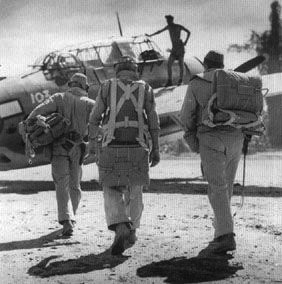
The pilot was complemented by the turret and belly gunners, but only the latter multiple duties and swapping locations on board. For the pilot, vision forward was excellent, being on an upwards slope and ahead of the wing leading edges. The turret gunner was basically seating in his position for the entire flight. The crew entered the fuselage via a starboard side hinged door, and all proceed as they could to their designated seats, being "stuck" in place during long hours. Only the jack of all trades radioman had some leeway inside the fuselage. When gatting rid of everything inside that did not compromised flight safety, the fuselage appeared roomy enough to enable a certain Wellington Smith to reach a record by carrying 17 pilots plus himself, into a TBM, flying from from Holtville in California to Naval Air Facility El Centro. Some transport versions were later built to carry VIPs and personal across aircraft carriers (see later).
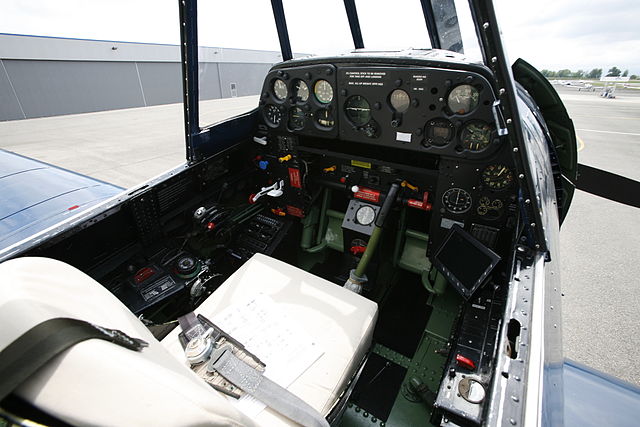
Cockpit view
Belly Gunner/Bombardier/Navigator
The MG gunner doubled as navigator, and had three positions inside the large fuselage: He was seated behind the pilot during flight to communicate more easily about the road taken and coordination with the rest of the squadron, but can double as bombardier, belly gunner and camera operator, aiming the bombs or torpedoes. The bombardier had a folding seat to quickly swap to the lower fuselage posting, both managing its bombardier/torpedo roles in the front section, or manage on the rear section the defensive machine gun under the tail section.The belly gunner had to provide navigation, bomb aiming, but also acted as radio: The generous radio equipment filled the "greenhouse" canopy, up to the rear of the pilot. They could be repaired via a "tunnel" along the right hand side. The space taken could be replaced by an extra seat, so four could be housed in the greenhouse on modern models.
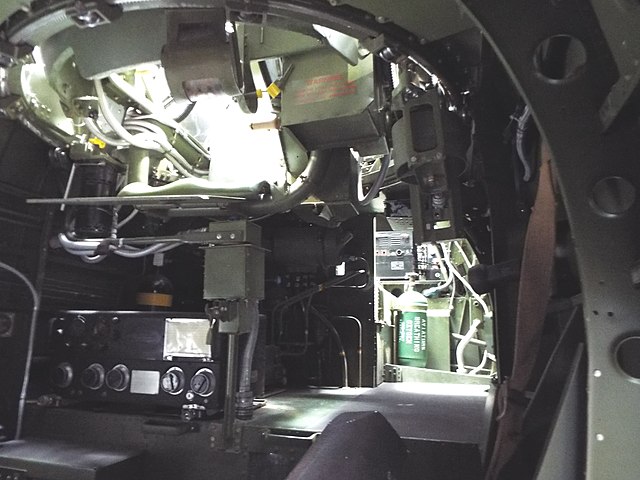
Interior, Belly Gunner/Bombardier post as seen from the access trap.
Tail Gunner
The dorsal, rear turret gunner did not swapped positions, being stuck at its post on a dedicated fixed seat, under a rounded framed enclosure. They were to defend it when in its most vulnerable, during an attack run. Unlike past torpedo bombers, the turret was a tour de force. Common on larger bomber, it was still rare on single-engine models. The British already "opened the ball" with models such as Fairey TurretDemon biplane, the Boulton-Paul Defiant in the RAF and Blackburn Roc in the FAA, both proving inept concepts in wartime. Why Grumman decided to go for this solution ? Simply the USN at the time looked at these applications and this was prewar, seeing an innovation worthy of adoption, wrote it down in the specifications, and Grumman had to comply. It's why it was also used on the Vought TBU (later TBY Seawolf).Fortunately, while the forward armament of the pilot reinforced (inexistant at first on both British models), the Grumman turret proved good enough to compensate. The chief engineer in charge put forward the turret traverse speed and elevation as paramount to cope with the speed differential with existant and upcoming fighters.
Powerplant:
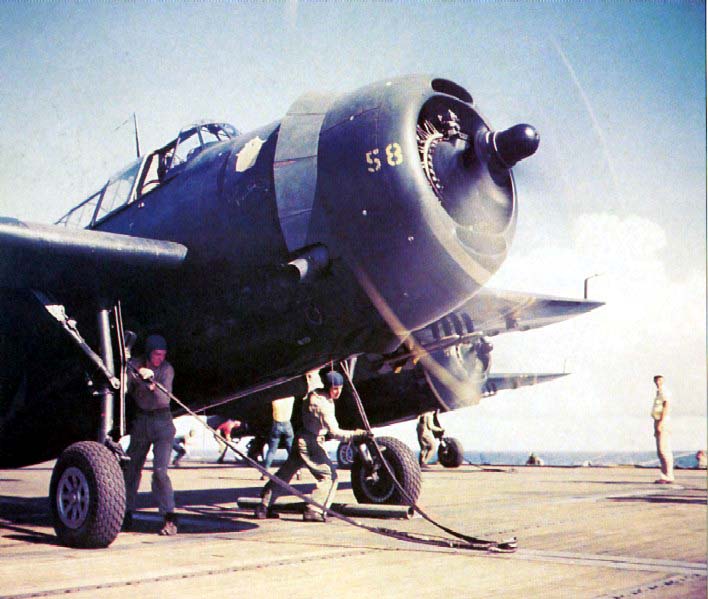
The Avenger used the "twin Cyclone" Wright Wright R-2600, declined into miltiple variants. It reached 1700 hp, and was also used by the Brewster SB2A Buccaneer, Curtiss SB2C Helldiver and F6F Hellcat prototypes. As the name indicated it was a 14-cylinder supercharged, doube rown, air-cooled radial with a 6+1⁄8 in (155.6 mm) bore, 6+5⁄16 in (160.3 mm) stroke, displacing 2,604 cu in (42.7 L). The engine block was 62.06 in (1,576 mm) long for 55 in (1,397 mm) in diameter, for a dry weight of 2,045 lb (928 kg). It used for valvetrain two pushrod-actuated valves per cylinder, with sodium-cooled exhaust valve.
It was also fitted with a single-stage two-speed centrifugal type supercharger (11 in diameter) with a blower ratio of 7.06:1 (slow regime) up to 10.06:1 (high). The Fuel system used Stromberg PR48A downdraft carburetor, with automatic mixture control. A task the pilot had no longer to worry about. The oil system used a dry sump, with one pressure pump and two scavenge pumps. This power was passed onto classic three bladed Hamilton Standard constant-speed propeller.
The prototype flew in August 1941 with R-2600-8, while the later XTBF-2 tested the P&W 1,900 hp (1,400 kW) XR-2600-10 and the XTBF-3 had the R-2600-20 engine, with the same output, and the XTBM-3 flew with R-2600-20 engine with a regime of 1,700 hp (1,268 kW) and 1,900 hp (1,420 kW) depending of the altitude. It became standard for GM production.
Fuel and Oil: The basic internal capacity was 330 US gal (275 imp gal; 1,249 l), in three center-section integral tanks. In addition, the Avenger could be equipped with two 58 US gallons (48 imp gal; 220 l) droppable slipper tanks, under the outer wings. There was even, but only for ferry flights, or when armed with rockets only, an option to install a jettisonable 275 US gallons (229 imp gal; 1,041 l) tank in the bomb-bay.
Performances:
The performances of the TBF Avenger (R2600-8) procuring a Power/mass ratio of 0.11 hp/lb (0.18 kW/kg) were the following: Top speed: 278 mph (447 km/h, 242 kn) at low level, cruise speed of 215 mph (346 km/h, 187 kn), service ceiling of 22,600 ft (6,900 m), climb rate of 1,075 ft/min (5.46 m/s). To compare this was 391 mph (629 km/h, 340 kn) top speed and 2,600 ft/min (13 m/s) climb rate for the Hellcat, so double. The Avenger's massive fuselage understandably created a lot of drag. Range was 905 mi (1,456 km, 786 nmi) at cruise speed, with only its internal fuel tanks, less than the Zero and even the Hellcat (945 mi).It was not supremely agile, but was very stable and generally reliable, without any vice so rookie pilot friendly. The could operate without escort but its defensive armament was not enough to protect it. Escorting Hellcats were mandatory. Escort carrier sailors nicknamed it the "turkey" compared to the Hellcat. But its was a "tough turkey" as all crews recoignised. Unlike past torpedo bombers, it stood a balanced chance.
Armament
Machine-Guns
The pilot at first had a single synchronized .30 caliber (7.62 mm) M1919 machine gun in the nose. A single defensive .50 caliber (12.7 mm) of the perforated short barrel was mounted close to the turret gunner's head in the rear electrically powered turret. A third one, 0.30 caliber M1919, hand-fired was placed on a flexible mount underbelly to defend the always vulnerable below tail angle. For this, the radioman/bombardier had to bend over in the belly, swapping positions from his usual folding bench, facing forward, to operate the radio and bomb sight.But soon pilot's complaints had the sinle 0.3 removed and replaced by two Browning AN/M2 0.5 cal. light-barrel in each wing, outboard of the propeller arc. This also added to the Avenger's strafing ability. The rear turret was a marvel of engineering for the time, different from aother's manufacturer's solutions. Designed by Oscar Olsen, his concept of using amplidynes—electromechanical amplifiers to rotate it was a breakthrough. His system used miniaturized components, tailor-built by GE on Olsen’s plans.
They turned out to be ideal to provide a rapid and consistent movement. There were plans to upgrade the turret from one to a twin mount, but the space aboard prevented it ultimately. The gunner controlled the turret with a pistol grip and its trigger, with a reflector sight and backup iron sight for targeting. He was protected like the pilot, by an armored seat, armored sides and armored glass. To escape when ditching, there was a small trap on his "fish bowl".
Mark 13 Torpedo
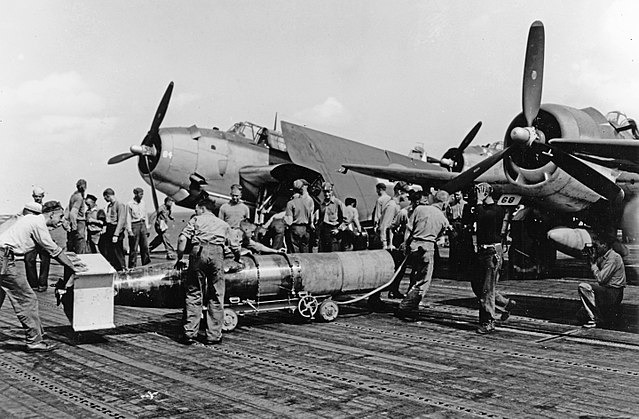
The Avenger had a large bomb bay, allowing for a single Bliss-Leavitt Mark 13 torpedo. This ordnance had a reputation or unreliability mirroring the larger Mark 14, as shown during the disastrous attack at Midway, when 35 out of 41 torpedo bombers that dropped their payload failed to score a single hit, while being lost in action. Throughout 1942, other actions showed a well below average hit probability due to a faulty proximity system. At first designed by BuAer and BuOrd, the first were tested and manufactured at the US Naval Torpedo Station, Naval Undersea Warfare Center (NUWC) at Goat Island, off Newport, Rhode Island. Problems were fully ironed out by 1944, but by then already, the concept of torpedo bomber was seen as obsolescent. In all until 1945, some 16,600 Mk.13 torpedoes were cranked up by multiple plants (Pontiac Motor Division, Amertorp Corporation, International Harvester), declined into the Mod 1, 2, 2A.
The Mark 13 could reach 6,300 yards (5.8 km), carrying a Warhead Torpex of 600 Ibs/270 Kgs (Mod 2) and using for the latter a Mk 8 contact exploder. This model was also operated by the Helldiver and by PT-Boats.
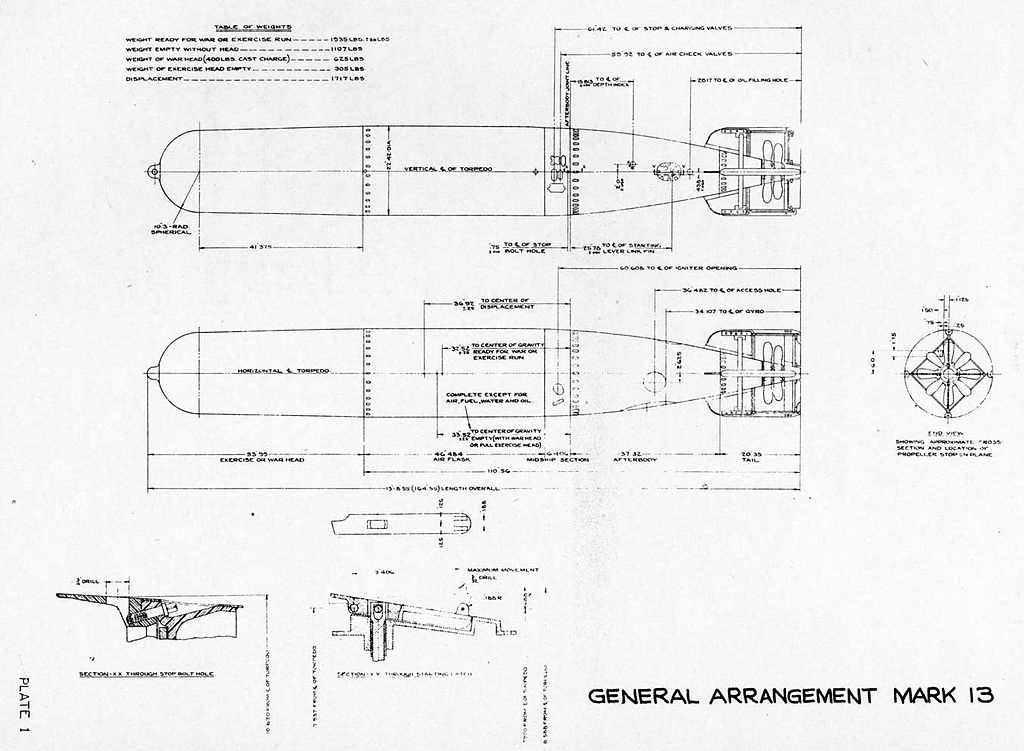
Mark 24 (Fido) Torpedoes
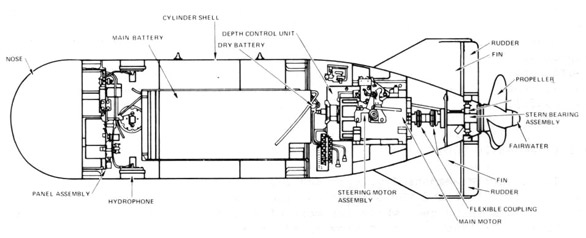
The 2,000 lb (907 kg) Mark 24 mine (Fido) acoustic homing torpedo was a late addition and replacement for the improved Mark 13 in 1942. The concept of a "homing" torpedo in the US emerged well before news from the German progresses with the Falke T-4 and Zaunkönig T-5 torpedoes arrived in 1943. This ultimately led to a submarine-based MK28 acoustic torpedo in 1944. But another lighter and shorter model was designed for aerial launch. The design started by late 1941 and was ready by late 1942. About 4,000 were produced for a total order of 10,000. The "fido" weighted 680 pounds (310 kg) for 84 inches (2.1 m) and 19 inches (48 cm) diameter, so on paper two could fit in the Avenger's bomb bay, but in pratice this was generally only one. The Mark 24 "mine" was slow but agile, it could reach 4,000 yards (3.7 km) underwater and carried a HBX 92 Ib (42 kg) Warhead trigerred by a Mk 142 fuze with contact exploder. It was successful in about 22% attacks. 264 attacks were launched with this weapon on all fronts, 340 dropped, mostly performed by Avengers. 31 U-Boats, 15 damaged, 6 sunk for IJN submarines, 18 damaged.
Bombs
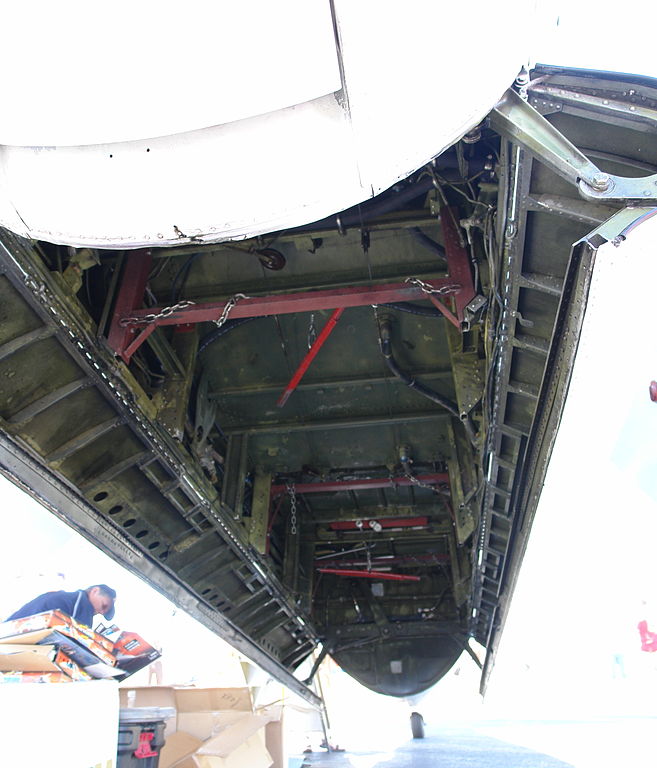
The bomb bay open
The TBF/TBM could carry a single 2,000-pound (907 kg) bomb, four 500-pound (227 kg) bombs. These were standard USN Navy ordnance with contact exploders. The Avenger used generally strafing or level-flight tactics for bombings, but it was rugged enough for short dives, keeping safety margins. It was rugged enough but this depended of the experience and condifence of the pilot. This was not recommended anyway. Boms were naturally imprecise, so rockets became a favorite from 1944.
Bombing with the Avenger was by default using the glide-bomb approach which for the pilot was two-handed between the stick and retrimming, but it stabilized well for clean and accurate drops. This also made conversrly for a very stable 78-knot carrier approach with good visibility over the nose.
The bombardier was helped in his task by its famous Norden bombsight, however in that case soon useless. It was geared towards high-altitude level bombing and noted these slanted approaches, but bureaucracy and inertia had the supply of this going on (and often dismounted). The bombsight was linked to an autopilot system ("Stabilized Bombing Approach Equipment") used for long flights and releaving the pilot from his heavy flight controls.
Usually the bombardier used a direct calculation from his small, slanted window peering into the dark bomb bay, which when opened provided a view down ahead between bombs. Drops were controlled by the pilot however, controlling the heading, airspeed altitude and distance and using his reflector gunsight above the instrument panel. This in fact made the multitasking bombardier/radioman/belly gunner redundant on the long run, especially when the Avenger was rarely used for torpedo runes anymore but in the ground attack role. It was limited to a two-men crew.
Rockets
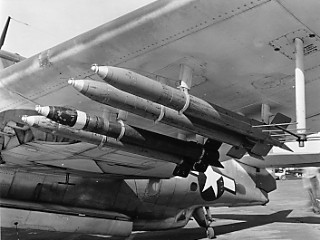
Up to eight 3.5-Inch (89 mm) Forward Firing Aircraft Rockets, 5-inch (127 mm) Forward Firing Aircraft Rockets or High Velocity Aerial Rockets. The first FFARs were developed in 1942, in service from June 1943, and the srelatively small (3.5-inch diameter) coupled with a non-explosive warhead, was meant for Anti-Submarine Warfare: The goal was puncturing the hull of an U-Boat. Later, a 5-inch anti-aircraft shell was attached to the rocket motor creating the 5-Inch FFAR (December 1943). It was slow by then down to 780 km/h (485 mph) and thus was developed the High Velocity Aircraft Rocket (HVAR). The later was for many years the staple of USN/USAAF heavy airbone rocket: 134 pounds (61 kg) for 68 inches (173 cm) in lenght, carrying a 7.5 Ib (3.4 kg) TNT/Comp B 45.5 pounds (20.6 kg) warhead, and solid propellant rocket motor using ballistite, extruded to reach 1,375 feet per second (419 m/s), cumulated with the aircraft's speed. These rockets saw action in WW2, Korea and Vietnam.
Depth charges
Aerial depht charges were naturally smaller and lighter than standard ships ones. It is less well known, but he Avenger could also carry out smoke laying missions, to conceal individual ships. A smoke tank was designed indeed to fit into the bom bay. Having 2000 Ib smoke in liquid form discharged by a dispenser meant a fairly large smoke curtain. Many tests had been done in the interwar and this tactic was still sued in some occasions.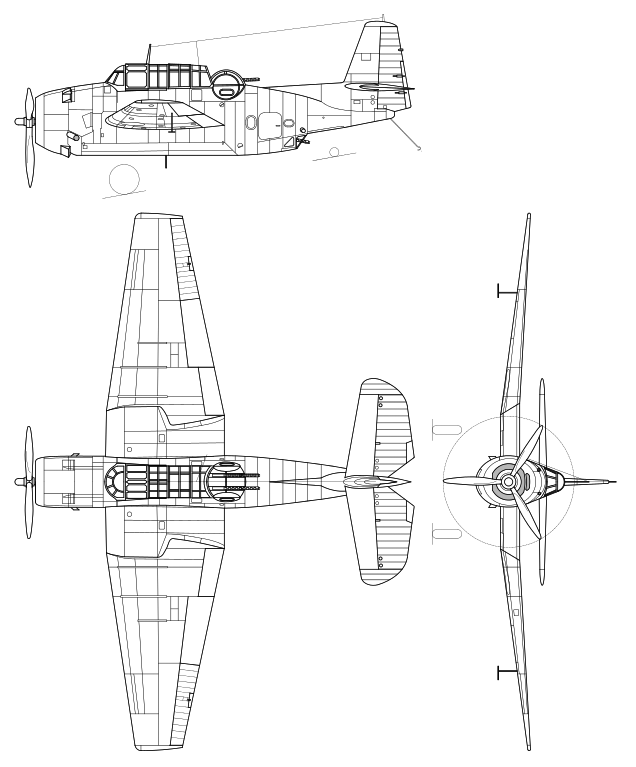
Rendition of the TBF
⚙ specifications | |
| Weight, Empty: | 15,536 lb (7,047 kg) |
| Combat Weight, max: | ???? |
| Fuselage Lenght: | 40 ft 1⁄8 in (12.195 m) |
| Wingspan: | 54 ft 2 in (16.51 m), or 19 ft (5.8 m) folded |
| Tail Height: | 16 ft 5 in (5.00 m) |
| Wing area: | 490 sq ft (46 m2) |
| Airfoil: | root: NACA 23015; tip: NACA 23009 |
| Cowling: | |
| Propeller: | Wright-Hamilton three-bladed Standard constant-speed |
| Propulsion: | Wright R-2600-8 Twin Cyclone 14-cylinder air-cooled radial piston engine, 1,700 hp (1,300 kW) |
| Fuel/Oil capacity: | 330 US gal in 3 center-section tanks, 32 US gal oil tank |
| Additional Fuel: | 2x 58 US gal droppable slipper tanks, outer wings, jettisonable 275 US gal bomb-bay |
| Top Speed: | 278 mph (447 km/h, 242 kn) |
| Range: | 905 mi (1,456 km, 786 nmi) at cruise speed |
| Armament: | 2x 0.3 M1919 in fwd and ventral, 1x 0.5 in M2 tail, 2000 Ib bombs, Mk13 Torpedo, Mines, 8x FFAR or HVAR |
| Protection: | |
| Crew: | 3, see notes |
Production: From TBF to TBM
On the afternoon of 7 December 1941, Grumman held a ceremony. A new manufacturing plant was opened officially and shown to the public. Little did they knew Pearl Harbor would happened at the same time, "earlier" in time far away. As the ceremony ended, guards arrived and the plant sealed off to avoid sabotage. It started work, tailored for the new "Avenger" (officially named in October 1941, but the press liked the idea this was that December day), and by June 1942 already, the first 100 TBF rolled of the line. The BF-1C succeeded the former TBF-1 with wing-mounted fuel tanks doubling its range and thus, giving longer "legs" to USN commanders to perform missions while keeping task force safer from harm. By 1943, production bottlenecks caused by the new F6F Hellcat, taking the bulk of Grumman's production pushed Grumman to start to phase out Avenger production and ask the Eastern Aircraft Division of General Motors to take over production, changing the acronym to TBM in a new plant in Ewing, New Jersey. Similar arrangement had been made with the F4F Wildcat.To achieve this transition, with the suspension by federal order of normal peacetime licencing rules, Grumman was obliged to send all blueprints and delivered a complete TBF-1, held together with sheet metal screws for the automotive engineers to disassemble it fully and "reverse engineering" it. But Ford being Ford, they redesigned the aircraft, tailored for automotive style production. This meant notably many simplification of design, without loosing the assential qualities. This meant faster processes and lower cost overall. Just like for the GM Wildcat, produced until 1945 despite it's age and filling the numerous escort carriers of the USN and Royal Navy (where they were called the "Martlet" and "Tarpon" and retook their original name in 1944-45 in the Pacific with the BPF.
Pre-production models
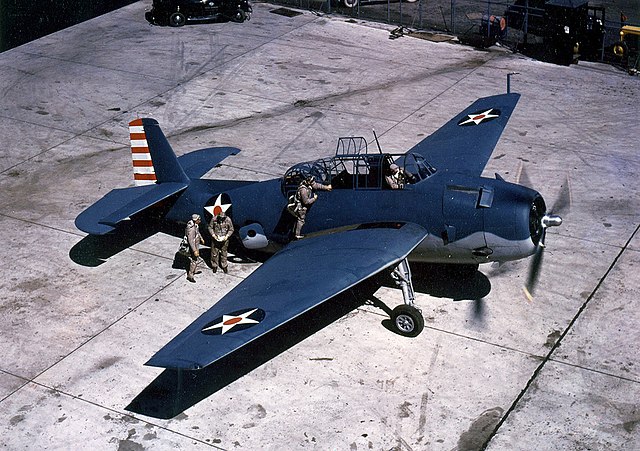
Early production model in april 1942
The very first production TBF-1 made its maiden flight on January, 3, 1942. Its first test operation checked all USN boxes, earning a global "very satisfactory" report, and with little changes if any for the finalized production, which was quite rare for a model design so quickly. Especially compared to the Vought Model, it was unheard of in the industry, even by wartime. By late July 1942, Grumman reported its first 100 deliveries, many still with the peacetime markings (white star with central red roundel, even for the earliest, a white and red tail).
USN group VT-8 was the first to receive this initial batch by January 1942, based on USS Hornet, first of the name (CV-8), still alive at the time. She departed to train on the the east coast of the US before heading with this rookie air group to the Pacific, and specifically to deliver them on Midway Island. After this, regular production models arrived (see later) and improvements were also on the way.
Variants
TB-1C
Production in wartime and the first combat reports led to increase the forward armament radically, pilots having sometimes missed opportunities, and during production two cal.50 (12.7mm) Browning M1920 heavy machine guns was added to the wings, fed in all with 1,200 rounds. This revision was made on the asembly line, as the TBF-1C. Thus retroactively the models not modified were redesignated TBF-1B.TB-1B/Tarpon Mk.I/Avenger Mk.I
They were intended for Lend-Lease (Fleet Air Arm). They arrived in Britain as the "Tarpon Mk I" modified to include British-required gear. At some point in 1943 they were redesignated "Avenger Mk I" for better allied coordination.Quick reminder:
XTBF-1: Prototypes, 1,700 hp P&W (1,300 kW) R-2600-8 engine, large dorsal fin for N°2 TBF-1: Pre-production and Initial production model (1,526 built) TBF-1C: Two 0.5 in (12.7 mm) wing guns, fuel increased to 726 US gal (2,748 l). (765 built) TBF-1B: Paper designation for Royal Navy Tarpon/Avenger Mk.I. TBF-1D: TB-1 Conversion with centimetric radar, right wing radome. TBF-1CD: Same but for the TBF-1C. TBF-1E: Conversions with additional electronic equipment. TBF-1J: Bad weather/night operations equipment and setting TBF-1L: Retractable searchlight installed in the bomb bay for night operations. TBF-1P: Photo-reconnaissance conversion for older TBF-1s TBF-1CP: Same conversion for the TBF-1C XTBF-2: Single TBF-1 re-engined with the P&W 1,900 hp (1,400 kW) XR-2600-10, prototype. XTBF-3: Same with the R-2600-20 engine (same output as the 2600-10), prototype. TBF-3: Paper production version of the XTBF-3 cancelled as it was passed onto GM.General Motors Avengers
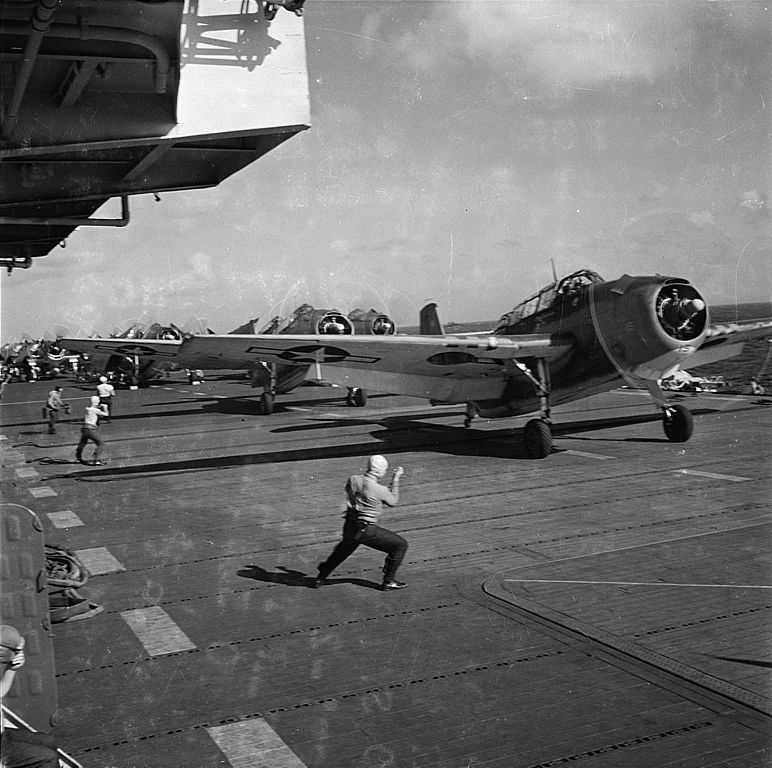
Avengers from VT-28 taking off fril the Independence fleet carrier USS Monterey (CVL-26) in June 1944
The Redesigned model which arrived wit instructions was known internally as "P-K Avenger", standing for "Parker-Kalon": Grumman facilitated the process of serially built the Avenger by GM, by delivering to the new Eastern facilities a special model assembled entirely with sheet-metal screws (from Parker-Kalon Corp.) for quick disassembly/reassembly. Grumman had doubts even that GM could pull it out, but the latter managed to largely out-do the New York company by producting 7,500 TBM ("M" standing for (general)"Motors"), versus 3,000 for Grumman. This was however still below Ford expectation, largely due to the difficult swap from car to aircraft production, betwee smaller tolerances, compexity, and constant in-line upgrades. But GM generally proved Grumman wrong, as Leroy allegedly said he would be surprised if Ford managed to built a single one...
TBM-1: GM production of the TBF-1. (550 built)
TBM-1C: GL production of the TBF-1C. (2,336 built)
TBM-1D: Convertion to centimetric radar, right wing radome (TBF-1D)
TBM-1E: Additional electronic equipment, as TBF-1E.
TBM-1J: All weather operations like TBF-1J
TBM-1L: Retractable searchlight, bomb bay, as TBF-1L
TBM-1P/1CP Photo-reconnaissance, same as TBF-1P/1CP
TBM-2: TBM-1 re-engined with 1,900 hp XR-2600-10 engine (single test model).
XTBM-3 Four TBM-1C prototypes, R-2600-20 engines.
There was no production TBM-2.
TBM-3
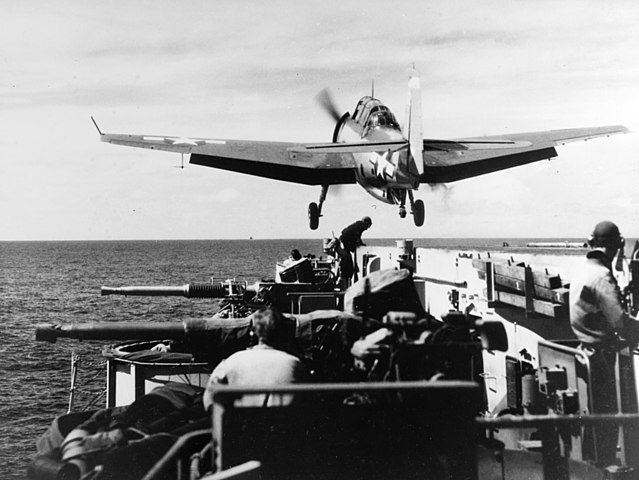
TBM-3 taking of from USS Makin (CVE-93), 1945
From mid-1944, the TBM-3 started production, fitted with a more powerful engine and extra wing hardpoints for drop tanks and rockets, further increasing range and capabilities. The last model, with further simplifications, the "dash-3" became by far the most produced of all Avengers, with circa 4,600 delivered until 1945, but at that date, they did not reached active units of the TF 38/58, which operated the dash-1 still by the summer of 1945. They were used mostly for ground attack by then, with bombs and rockets.
TBM-3:s TBM-1C with new engine and double cooling intakes and minor changes. (4,011 built)
TBM-3D: Same, with centimetric radar, right wing radome.
TBM-3E: Stronger airframe plus search radar and no ventral gun. (646 built).
TBM-3H: Surface search radar conversion.
TBM-3J: All weather operations variant
TBM-3L: Bomb Bay retractable searchlight TBM-3M: "Tiny Tim" rocket launcher conversion underwing.
TBM-3N: Dedicated night attack version.
TBM-3P: Photo-reconnaissance version.
TBM-3Q: Electronic countermeasures version (very first USN type) with gun turret.
TBM-3R: 7 passenger transport conversion for carrier use.
TBM-3S: Dedicated anti-submarine (ASW) version (postwar).
TBM-3U: General utility/target version (postwar).
TBM-3W: Airborne early warning control/relay platform, AN/APS-20 radar (cold war).
TBM-4
The last planned version was the TBM-4, with nearly 40 variants planned, but it was cancelled after V-Day in the summer of 1945. The XTBM-4 were three prototypes based on TBM-3E (Surface search radar) but the modified wing had a reinforced center section and new folding mechanism to allow a better way to not damage the radome and stay compact. The TBM-4 was the cancelled production version, with 2,141 initially ordered.Total Production by Grumman and General Motors combined reached 9,836 or 9,839 planes depending of the sources and inclusion of prototypes. This was a large pool providing sells to other navies postwar, and added to this, many modifications were made after the war, with full modernizations in the fifties, notably as a dedicated ASW search and destroy plane which equipped many navies until the 1960s. A remarkable achievement for the model designed and adopted so quickly. Happy customers and users post war were Brazil, Cuba, France, Japan, the Netherlands, Nicaragua, and Uruguay.
Combat use (USN)

The first 100 delivered in May-June were assigned to three carriers out of Pearl Harbor in December, constantly engaged afterwards, and thus not resupplying their air park, "used to the bone". They missed thus the Battle of Midway, with an exception. The beginnings of the Avenger were an attack on Tulagi, May 4, 1942, before the battle of Coral Sea, they targeted ships of the Japanese "B" invasion fleet.
Early Operations: Midway and the Solomons Campaign
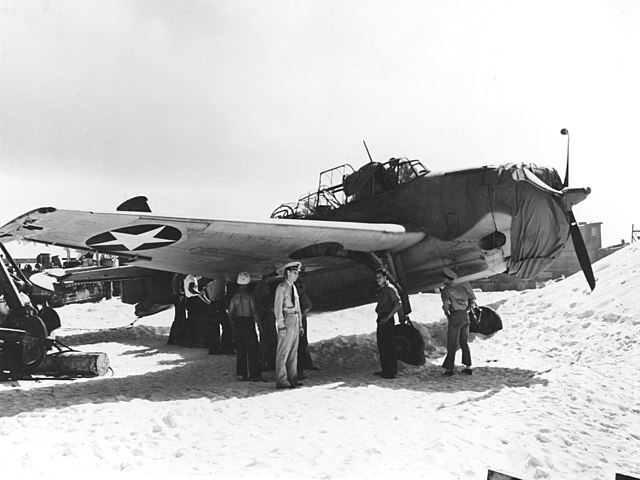
Surviving VT-8 TBF-1, 24 June 1942.
Six TBF-1s based on Midway Island in VT-8 (Torpedo Squadron 8) would participate, alongside worn out Devastators landed from USS Hornet. Both types equally suffered heavy casualties, arrived in penny packet and facing a formidable Japanese combined combat air patrol: Five were shot down and the sole survivor returned so heavily damaged (with one gunner killed, the rest of the crew wounded), it was written off after quick inspection. That was a good test of their ruggedness though. Greater numbers of Devastators were sent off, none returned.
Author Gordon Prange argued that the use of the old Devastator somewhat spoiled the "Miracle at Midway" and that complete victory could have been achieved if Avengers would have replaced them, although it's really dive bombers that saved the day here. The lack of succes of US torpedo bombers in 1942 and even up to late 1943 combined inexperienced pilots, lack of fighter cover, and poor aerial torpedoes as explanation. Later these points were fixed and the Avenger could show its true potential being unleashed in many battles and operations.
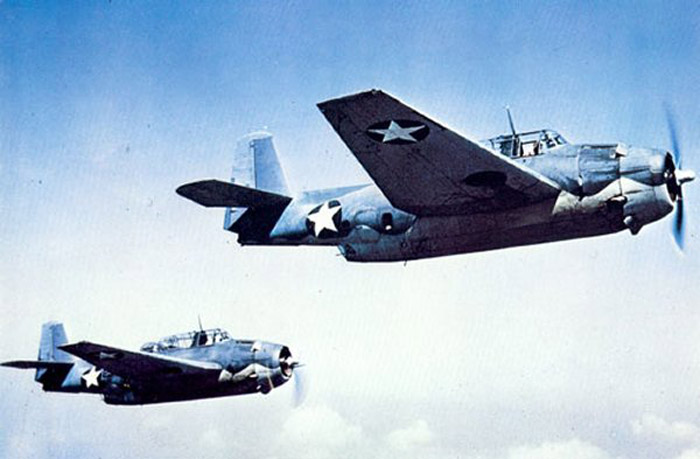
Avengers in flight in late 1942
On 24 August 1942, Avengers showed their worth at the Battle of the Eastern Solomons from USS Saratoga and Enterprise: 24 TBFs sank the light carrier Ryūjō and shot down a "Val", for the loss of seven.
Next, Avengers from both the Marine Corps and Navy participated in the 1st Battle of Guadalcanal in November 1942, finished off IJN Hiei, crippled during a night fight.
ASW role in the Pacific and Atlantic
Their traditional surface role or torpedo attackers was complmented by a recoignised ASW role: Collectively, Avengers and Tarpons claimed for the allies around 30 submarine kills, mostly U-Boats but also several Japanese, like the I-52. They were recoignised very effective sub-killers in the Pacific as well as in the Atlantic from escort carriers. And when they did not sunk their preys, they obliged U-Boat to dive, allowing escorts to steam ahead to catch them, by forcing them to keep their head underwater. With their far greater range compared to the Wildcats they also provided air cover for the convoys, often spotting first and reporting surfaced U-Boats.Late operations (Island hopping)
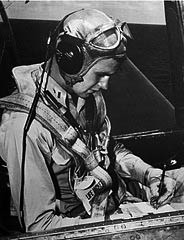
One distinguished Avenger pilot was a future president: In June 1943 (not even aged 19), George H. W. Bush was commissioned as the youngest naval aviator of the time, flying a TBM in VT-51, based on the Independence class USS San Jacinto. He was shot down on 2 September 1944 close to Chichi Jima, hitting the radio tower target as expected and bailing out. His crewmates died but he was eventually rescued by USS Finback, receiving a DFC for his action.
Another famous Avenger pilot was future actor Paul Newman, a rear gunner which did not qualify as pilot, being color blind. He operated from the escort carrier USS Hollandia in the last days of the war, being 500 mi (800 km) of Hiroshima when the A Bomb was dropped.
 Grumman TBF-1 Avenger of VT-5 about to take off from USS Yorktown (CV-10), circa late 1943.
Grumman TBF-1 Avenger of VT-5 about to take off from USS Yorktown (CV-10), circa late 1943.After the "Marianas Turkey Shoot" Admiral Marc Mitscher scrambled a combined air force of 220-aircraft to catch the IJN task force. About 300 nmi (560 km) away Hellcats, TBF/TBMs, and dive bombers found them and attack, taking many casualties, and many -especially the fighters- never returning or landing by night in perilous conditions. Avengers from Independence-class USS Belleau Wood claimed IJN Hiyō.
Another operation of note was operation Ten Go: Avengers helped sinking the super battleships Musashi and Yamato, but they were in all operations from the reconquest of the Solomons to the Mariannas, the Philippines, and up to Iwo Jima, Okinawa, raids on Formosa, and summer 1945 final raids on Kyushu and the home island in general. In 1944, the same Avengers, equipped with homing torpedoes in the Pacific, started to attack enemy submarines and made quite a tally, starting with I-56 in the Indian Ocean.
The Atlantic Campaign
Another aspect of the big bird which is often overlooked is about the Battle of the Atlantic: It concerns moslty the fleet air arm which deployed the Tarpon Mk.I from most of its escort carriers, in ASW escort missions, where it was found quite acceptable. Most of the 30 submersibles sunk by the Avenger were German U-Boats. But in reality this "hunting board" is deceiptive as many more were co-claimed by surface ships. The tactic used was simple: Avengers armed with rockets and depht charges would spot, attack a surfaced U-Boats, report it to the fastest escort vessels, generally destroyers, keeping it all the way "the head underwater" by dropping depht charges. When submerged, the U-Boat crawled to a mere eight knots (for the VIIC) and thus, a hunter killer group could despatch 30-kts destroyers, leaving regular convoy escorts (mostly Destroyer Escort, frigates and corvettes) in close-in defence.Camouflage research:
Modified TBM Avengers researched a counter-illumination camouflage. They were fitted with Yehudi lights, forward-pointing which were automatically adjusted to match the sky's brightness and create an active concealment. This was a form of early "stealth" only valid for the guns operators since radars could pick them up anuway. But they no longer appeared as dark shapes which was quite useful for their slow, low flying torpedo runes. This was the result of the Canadian navy's diffused lighting camouflage research. It showcased a modified TBM arriving to 3,000 yards (2,700 m) of an oberver before being seen, which was the ideal rocket launching range. This however came too late in the war for mass production.Other Operators of the Avenger
Fleet Air Arm
The Avenger became the Tarpon in Royal Navy's Fleet Air Arm service. The British Admiralty test pilot Roy Sydney Baker-Falkner was the first to fly it at RAF Boscombe Down in 1942. When the FAA started to operate in the pacific, like the Wildcat, narmed Martlet, the name "Tarpon" was discontinued, "Avenger" used instead for the sake of interoperability and communication standards. The first 402 TBFs delivered by lend-lease became thus in 1944 the "Avenger Mk I", followed by 334 TBM-1s called "Avenger Mk II", and 334 TBM-3 as the Mk III. The first Avenger for the Fleet Air Arm arrived early in 1943, also piloted by Eric “Winkle” Brown. He found its spun rapidly and dangerously if anti-spin controls were not pulled in time. Thus went stright into the flying manual, pilots from there were informed to avoid intentional spins.They operated, despite their large size, on various aircraft carriers, notably the entire Archer and Attacker class, related to the US-built Bogue class.
Outside escort carriers, FAA Avengers also served with fleet carriers. They operated in the Indian Ocean, notably working out in cooporative training during operation 'CLUB RUNS', renamed "avenger", and put to the test during Operations Meridian I & II against Japan's remaining oil refineries. Later they took part in various cooporative exercizes in the Pacific, forming Task Force 57, and deployed during Operations ICEBERG I, ICEBERG OOLONG, ICEBERG Redux and ICEBERG II. I sincerely hope that armouredcarriers.com will have a go on the Avenger to expose the FAA side of the story more in detail.
Some Avenger still served on the European theater, mostly those from land bases on the British Isles and from escort carriers. A most unusual and interesting kill was shooting down a V-1 flying bomb on 9 July 1944, which was close enough at some point to an FAA Avenger for Telegraphist Air Gunner, Leading Airman Fred Shirmer (from the dorsal one) fired from 700 yards (640 m) and managed to cripple either its engine or wing, since it veered and crashed. Shirmer would go to the BPF and earn a DSM for Operation Meridian at Palembang. In January 1945 he managed indeed to shot down a rare Nakajima Ki-44 "Tojo" in low level combat over the jungle. The FAA also made tests to try new weapons, such as the Highball "bouncing bomb" (codename Tammany Hall), and trials were performed by three modified Avengers, but without much success.
Deliveries and variants includes:
-Tarpon GR.I: Early TBF-1 initial transfer of 400.
Avenger Mk.II: TBM-1/TBM-1C models, with 334 transferred.
Avenger Mk.III: British TBM-3 (222 delivered)
Avenger Mk.IV: british TBM-3S (70 ordered, then cancelled)
Avenger AS4: British TBM-3E, only delivered postwar, used until replacement in the late 1950s
Avenger AS5: British TBM-3S, also postwar, but modified with British equipment
Avenger AS6: TBM-3S, British equipment and new centrline radome. 100 AS5/6 delivered by 1953.
RNZAF: Royal New Zealand Air Force
The only other operator in World War II was the Royal New Zealand Air Force which used the type primarily as a bomber, equipping Nos. 30 and 31 Squadrons, with both operating from South Pacific island bases during 1944 in support of the Bougainville campaign. Some of the Avengers were later transferred to the British Pacific Fleet. In 1945, Avengers were involved in pioneering trials of aerial topdressing in New Zealand that led to the establishment of an industry which markedly increased food production and efficiency in farming worldwide. Pilots of the Royal New Zealand Air Force's No. 42 Squadron spread fertilizer from Avengers beside runways at Ohakea Air Base and provided a demonstration for farmers at Hood Aerodrome, Masterton, New Zealand.Postwar, Avengers were still operated for years in the No. 30, 31, 41 and 42 Squadrons of the RNZAF.
Cold War Operators
Both the USN and USMC still operated the Avenger for some more years, notably in specialized ASW variants such as the TBM-3W. One incident became a popular mystery, still unresolved today in the infamous "bermuda triangle": This was the entire disappearance of training Flight 19, five TBM-3s Avengers from Naval Air Station Fort Lauderdale, lost in December 1945. No trace of the missing aicraft was ever found, fuelling much conspiracy theories. This was featured in Spieleberg's movie "encounters of the third kind" among others, and generated a lot of literrature.The cold war FAA use

British Pacific Fleet Avenger II from HMS Victorious, late 1944
Regular Avenger Mk.I-III were gradually retired after the war, but in 1953, the Royal Navy starting to acquire anti-submarine warfare versions under the Mutual Defense Assistance Program (MDAP). These were designated Avenger AS Mk IV or AS Mk V, used in the ASW role until the arrival of the Fairey Gannet from 1955. From there, they were exported still under MDAP to France, Japan, Canada, and the Netherlands.
Canada: The RCNAF

RCAN Avenger ExCC ASW with MAD system, 1950
Canada became a primary user of the model, using 125 surplus aircraft (TBM-3E conversion) in 1950-1952, replacing the Fairey Firefly. However the RCAN was just swapping its naval policy way from anti-submarine warfare (ASW) so they were soon reconverted. 98 were overhauled and received a brand new ASW suite: The radar and the electronic countermeasures (ECM) systems as well as sonobuoys were new, the dorsal turret removed and replaced by an clean plexiglas observation canopy, designated AS 3.
Of these, a good number recveiced the new US magnetic anomaly detector (MAD), a boom located on the left side of the fuselage, redesignated AS 3M. In addition only eight Avenger Mk.3W2 (TBM-3W) were converted. In 1954 the admiralty however voted for its retirement and gradual replacement by the more tailored, roomier, long range Grumman S-2 Tracker for North Atlantic patrols. Deliveries only started from 1957, while Avengers were gradually retired and reassigned to training duties, the first retired from July 1960.
Other Operators
Brazil
The Brazilian Naval Air Force adopted the Avenger, operating three in ASW role in the 1950s, but inly for training on the Aircraft Carrier Minas Gerais (A-11).Cuba
Seven TBM-3S2 were purchased in 1956 for the Cuban Navy, but they were retired by 1960.France
Also using the Grumman Hellcat and Bearcat in Indochina, France adopted postwar the Avenger. The Aéronavale operated the 143 they received between four carriers and bases, of four types: Model 3E with rear turret, Model 53 for ASW research, 3S for ASW strike, Model 3W for radar detection, search and navigation. After the 143 from the US, 27 were delivered from UK od the AS Mark.4 type for spare part. The 4.F flotilla was the first equipped in 1951. Three flotillas 4.F, 6.F and 9.F flew the TBMs, which operated in pairs as the 3W detected subs, the 3S attacked. In all, 4.F, 6.F, 9.F, 3.S, 5.S, 10.S, 15.S, 54.S, 56.S. used them, the last one was retired in 1965. The TBM was replaced by the Breguet 1050 Alize.JSDMF
Japan Maritime Self-Defense Force operated Hunter-Killer Avengers groups in the 1950s and 1960s.Royal Netherlands Navy
The RNN or Dutch Naval Aviation Service, operated the Avenger in the 1950s.Nicaragua
The Nicaraguan Air Force used the AvengerUruguay
The Uruguayan Navy operated 16 TBF Avengers in 1949-1963.In Civilian use
Some Avengers continued earning their keep until more than sixty years after their debut. Until recently, at least one aerial firefighting operation used Avengers as firebombers and/or fire spotters over Canada. Many ended in the caring hands of collectors and warbird museums.Among other uses, most were converted as spray-applicators and water-bombers in North America, with the greatest concentration in New Brunswick. The Forest Protection Limited (FPL) of Fredericton, there operated the world's largest civilian Avengers group for many years, starting operations in 1958 after acquiring 12 surplus TBM-3E from the RCN, and it peaked in 1971 with 43 in use. The company sold three to museums or private collectors and other followes, whereas some crashed until the 2000s.
Avenger stull flies as warbirds in private collections and are a popular airshow feature, quitre commona also in aviation museums. By 2020, the Commemorative Air Force sports three TBM at different locations.
Replacing the Avenger: Grumman, Douglas and Martin
In 1944, the USN started to look at a replacement for the Avenger, but already looking at a more "universal" model, like those looked for also in the British Fleet Air Arm. The Typical "do it all" of the USN planned to enter service in 1945 was ideally a large, powerful single-engine model with a single seat, its pilot and no gunner. Indeed, it was to be modelled as fast as a fighter, precisely to perform the following roles:-Long range escort fighter
-Fighter Bomber
-Torpedo carrier
-Dive Bomber
-Reconnaissance model
-ASW patroller
Owing to the classic adage that a "do it all" could be just mediocre or passable in any of these compared to specialized model, this was still the credo of this time. In 1945 indeed, USN Fleet carriers counted on four models to cover for all their needs: The Avenger as a versatile torpedo bomber, the Helldiver as a specialized (but mediocre) dive bomber, the F6F Hellcat as a fighter (soon to be replaced by the F8F Bearcat), and the F8U Corsair as fighter bomber. Having in single model to cover all roles, or at least all but pure "fighter" role, looked logical on paper, simplifying maintenance, storage, supply and operation. However, looking at the numerous delays of the very complex F-35 programm today, this was not an easy task, imposing many compromises to fill all these roles. From there, many companies participated, but only three manufacturers emerged as "winners", obtaining orders for comparative tests, leading to a small production as they all fitted niches for the same basic "A" specification (given later, followed by the manufacturer code), enjoying later very different fates. Here they are:
Grumman AF Guardian
 The designated successor, built indeed in replacement but embracing a particular aspect only the Avenger, as used in the Atlantic: It became the first purpose-built anti-submarine warfare (ASW) carrier-based aircraft, flying i December 1945 but introduced in 1950, built to 389 units and retired by August 1955, early than many modernized and reconverted Avengers. Redesignated as AF-2W (TB3F-1S) and AF-2S (TB3F-2S) for its two versions and commencing service in September 1950 VS-24 and later with VS-25, the 193 AF-2S Guardians built were succeeded in a sense by the 1952 AF-3S (ASW hunter) using a magnetic anomaly detector (MAD) for detection (40 built).
The designated successor, built indeed in replacement but embracing a particular aspect only the Avenger, as used in the Atlantic: It became the first purpose-built anti-submarine warfare (ASW) carrier-based aircraft, flying i December 1945 but introduced in 1950, built to 389 units and retired by August 1955, early than many modernized and reconverted Avengers. Redesignated as AF-2W (TB3F-1S) and AF-2S (TB3F-2S) for its two versions and commencing service in September 1950 VS-24 and later with VS-25, the 193 AF-2S Guardians built were succeeded in a sense by the 1952 AF-3S (ASW hunter) using a magnetic anomaly detector (MAD) for detection (40 built).
The last arrived in March 1953 and they saw action during the Korean War, but was unpopular, both underpowered and heavy on the controls, with a high accident rate. Its replacement came just in time as the twin-engine Grumman S2F Tracker as a combined hunter-killer, making for a quick removal of the Guardian until 31 August 1955, some still active with the ENN Air Reserve until 1957.
Martin AM Mauler

The Mauler was a "jack of all trades", but specialized as a torpeod attack plane, carrying three of these, and thus, could be described as the most obvious sucessor of the Avenger. Developed from the XBTM which first flew on 26 August 1944, the large single-seat attack aircraft went through numerous development delays and only came into service by 1948, seeing a small production. It proved indeed troublesome and only remained on the frontline for two years, retired after 1950, and replaced by the simpler Douglas AD Skyraider. Some stayed in reserve squadrons until 1953 and a few were converted into the early AM-1Q electronic-warfare aircraft (distant relative to the Prowler).
Douglas AD Skyraider

Douglas AD-1, VA-3B, USS Franklin D. Roosevelt, 1948
Last of the three, the Douglas AD also flew in WW2, first flying on 18 March 1945, and serted service in 1946. It was a very simple and rugged model and thus, succeeded with ease to the Mauler and Guardian in the generic attack role. Amazingly, it was delined into many versions and remained throughout Korea and Vietnam the only single seat piston engine model frontline in the US Navy. The US retired the very last as the conflict ended, in 1973, but some soldiered on in the 1980s, like 1985 for the Gabonese Air Force. It was the only success story of this trio.
Final assessment: A "tough Turkey"
[caption id="attachment_37114" align="aligncenter" width="960"]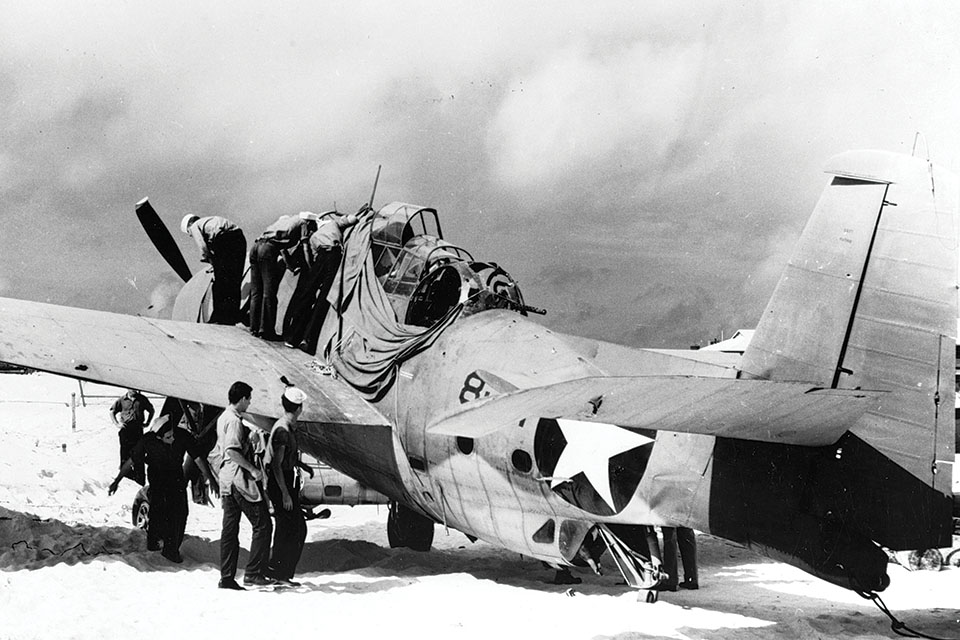
Sole survivor of the six VT-8 Avengers attacking on June 4, 1942 back at Midway, credits Naval History and Heritage Command. A bad start for the "turkey"
With a maximum takeoff weight of 17,893 pounds, the Avenger was WW2' largest naval carrier airplane in anvy navy. It was even larger and heavier as a single-engine than the legendary USAAF' "Jug", the P-47 Thunderbolt, 400 pounds lighter. The Avenger also could lift one ton of payload and more, between a 2,000-pound torpedo or four 500-pound bombs, which was unique. The other carrier bomber of the time, the Curtiss Helldiver, carried the same in its bomb bay, but was far less reliable. But it was somewhat underpowered.
See a nice color cutaway at historynet.com
The naming was a common myth as it made its first public appearance on December 7, 1941, but the name appeared in documentation by early October, two months before Pearl Harbor. The press at the time biaised this to fit a morale-boosting wartime narrative essentially. Pilots joked it could fall faster than fly. Some full payload takeoffs, especially from tiny escort carriers dekcs, certainly felt true. It was safer for them to be catapulted but the 45 feet ones on CVEs could only propelled the beast to 19 knots, into the wind and 90 knots was barely its flying speed. Taking speed at the crest of the wave after a dive was the only solution. It seems ponderous. The Hellcat had a better engine and was much lighter in comparison.
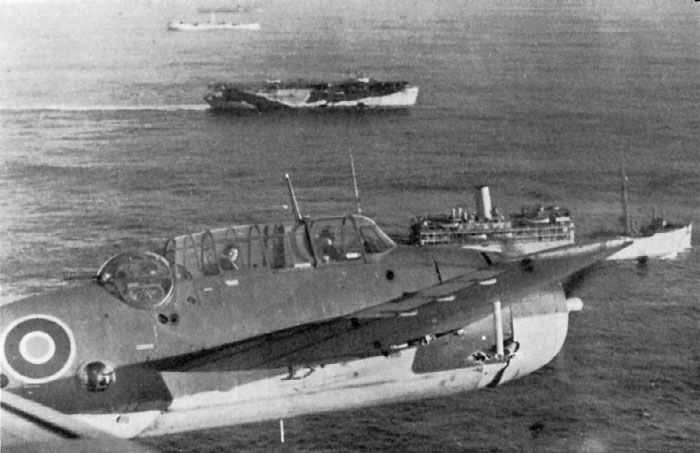
FAA Avenger II over its carrier, HMS Biter, flying over the convoy
Its performances as a torpedo carrier were close to mediocre at first due to the initial faulty Mark 13 aerial torpedoes, but this was solved in 1943, and results started to show. It could carry bombs and was mostly using them in strafing attack, but it could dive as well, although this was not recommended, bing the primary role of the Helldiver.
By 1944 it received hard points under the wings to operate launch rails for 5-inches HVARs rockets, providing a destroyer’s broadside in capabilities. By inerty alone, without even detonating, attacks on submarines saw them punch right through their hull, preventing them to dive. As pilot's training improved, they became even adept at launching them into Japanese caves during air support missions over Okinawa in 1945. Also in 1944-45, the Avenger received the deadly "fido" an early acoustic model which far better performances.
The aircraft's ruggedness and stability compenasted largely for it's truck-like responsiveness, and provided with good radio facilities and docile handling they could be used as acommand aircraft for Air Group (CAGs) as well during raids. Ceiling and range was better than any previous USN torpedo bomber anyway, far better than the Nakajima B5N "Kate". However later IJN models were certainly better in performances. Later Avengers proved adaptable enough to be turned into EW platforms (Electronic Warfare) postwar while radar equipments were more and more sophisticated, until the late Canadian ASW variants using MAD detection system to track down Soviet submarines in the north atlantic and GIUK gap.
USN Models, Grumman TBF

Grumman XTBF-1, second prototype. The first crashed, the second inaugurated a large dorsal fin.

TBF-1 preserie, VT8 NAS Norfolk, May 1942

TBF-1 from VT-8, CV3 USS Saratoga, mid-1942

TBF-1, VF-8, Midway Island 4 June 1942

TBF-1, USS Enteprise late 1942

TBF-1, Unknown unit, june-October 1943

TBF-1 Training Sqn. 1943

Onboard USS Randolph (CV-15), 1943

TBF on USS Block Island, 1943

TBF-1, USMC unit, 1943
USN Models, General motors TBM

TBM-1 of a night operation training unit, USS Bataan (CVL-29), 3 February 1944

TBM-3, USS Bunker Hill, 1944

TBM-3 Alternate Camouflage SC-II (land based)

TBM-3, USS Essex 1944

TBM-1Cn VT-51 San Jacinto June 1944

TBM1C, VC-42, USS Bogue, Sept. 1944

TBM-3 "Bayou Bell", USS Essex, 1945

TBM-3, VC-97 USS Massar Strait, February 1945

TBM-3, VT-82 USS Bennington, CV-20 February 1945

TBM-3 VT(N)-90 USS Enteprise, March 1945

TBM-3, VT-46 USS Independence, April 1945

TBM-3, Eastern Division, VMTB-233, USS Block Island, April 1945


TBM-3 VMTB 132, USS Goucester, July 1945

TBM-3, VT-88 USS Yorktown, CV-10 July 1945

RBM-3, VC-83, USS Sargeant Bay, (CVE-83), July 1945

TBM-3, VT-33, USS Sangamon (CVE-26), 1945

TBM-3 of Flight 19 USMC, NAS Fort Lauderdale, December 1945, of Bermuda Triangle fame.
Fleet Air Arm Models

Avenger Mk.I, HMS Indefatigable

TBF Tarpon Mk.I Donibristle, mid-1944

Tarpon II, HMS Empress, Channel, mid-1944 with invasion bands

Avenger Mark 1, 711th Squadron, RNAS Crail, 1945

Avenger AS Mk.4 TBM3E, 1947
Canadian Models

TBM 3S from 825 Sqn, HMCS Magnificent
Cold war international service
The Avenger was still used for several years by the USN and Marines after the war. A batch of them even became entangled with one of the enduring mystery surrounding the "Bermuda Triangle": On 5 December 1945, a flight of five Avengers (Flight 19) completely disappeared without explanation or leaving a single trace. Edward Van Winkle Jones in Associated Press was the first to report in September 1950 and this generated tons of books or hypothesis, even featured in Spieleberg's "Close Encounters of the Third Kind". More seriously, the Avenger as a torpedo bomber was getting old, and it was soon found more appropriate as a specialized ASW patroller.
RCNAF TBM-3E AS Mk.4 in 1947

TBM-3U VU-4, NAS Norfolk 1948

TBM-3R COD VR-24 Naples 1952

TBM-3S2 JMSDF Kanoya air base, Sasebo 1958

Avenger AS. Mk.4 ECM6 831 Sqn. RAF Syerstone base, 1958

USN TBM-3W in the 1950s

TBM3E2 of the Luchtvaartdienst, 1954

TBM-3 AS Mk.4 of the Brazilian Navy, 1955

TBM-1 of the Uruguayan Navy, 1956

TBF-3S VS-880 RCN, 1957

French Aeronavale TBM-53 of 4S Sqn. in 1958.

French TBM-2S3 6F 1950
Photos

Avenger dropping a torpedo

VT-90 in flight, January 1945

USN Avenger TBM 3W prototype in 1946

Japanese JSDMF TBM-3W in 1950
[caption id="attachment_37116" align="aligncenter" width="700"]
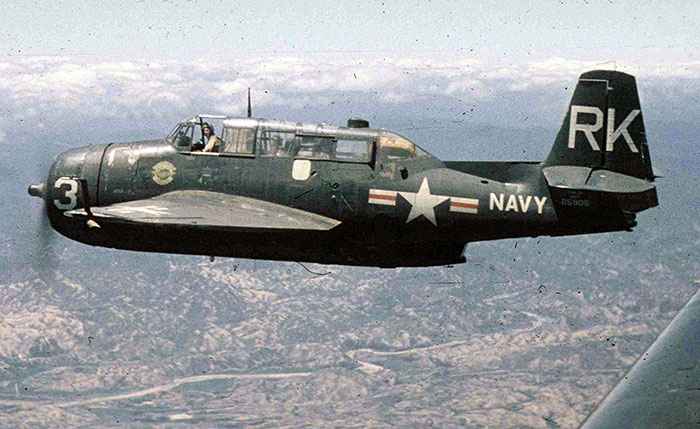
*TBM-3R: Until the arrival of twin-engined models such as the Tracker, carrying personal was impossible between aicraft carriers. The Avenger became the first dedicated (but improvized) transport conversion, designated Carrier Onboard Delivery (COD) transport. But it was a post-war conversion until twin-props arrived. The seven-passengers (or five passengers plus a loadmaster and pilot) were accomodated between the greenhouse, in which the turret was eliminated, the canopy extended, the radio removed, and additional seats installed behind the bomb bay. Two were seated in tandem behind the pilot and two more behind them, and the last two in the rear belly, on the left and right side crossing legs. This even allowed extra space for personal effects, suitcases and haversacks of cargo in the bomb bay in chich was installed a basket system. The TBM-3R developed in 1951 led to 27 converisons. It also was used by Japan outside the USN, until the arrival of the Grumman TF-1 (C-1) from 1957 and in the 1960s, the turboprop Grumman C-2 greyhound. See also[/caption] [caption id="attachment_37117" align="aligncenter" width="960"]
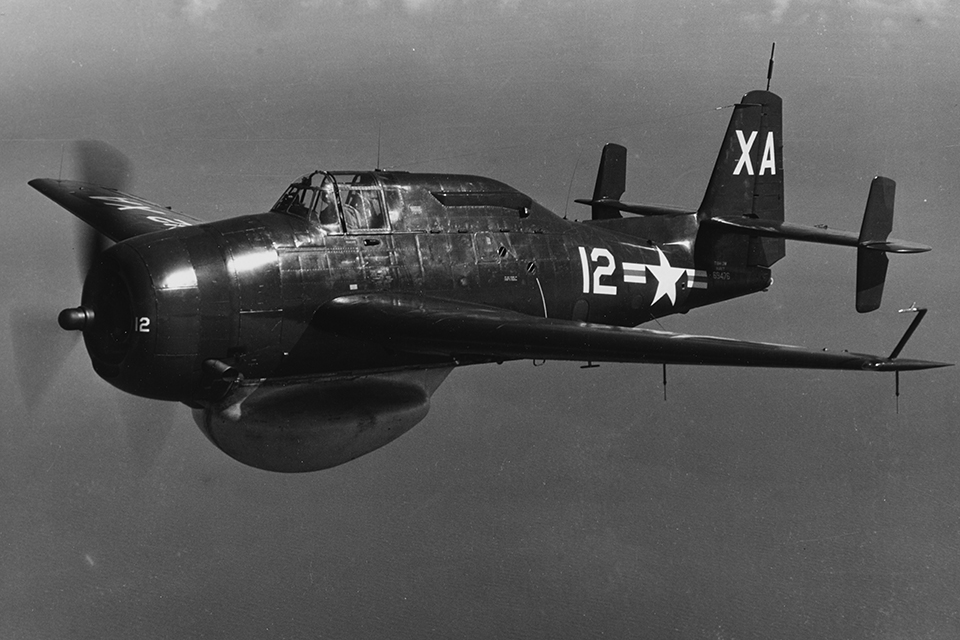
In the summer of 1945, a few highly modified Avengers inaugurated a APS-20 search radard detecting low flying aircraft. The TBM-3W was further refined postwar, but became the first WW2 airborne early warning model. (U.S. Navy)[/caption]
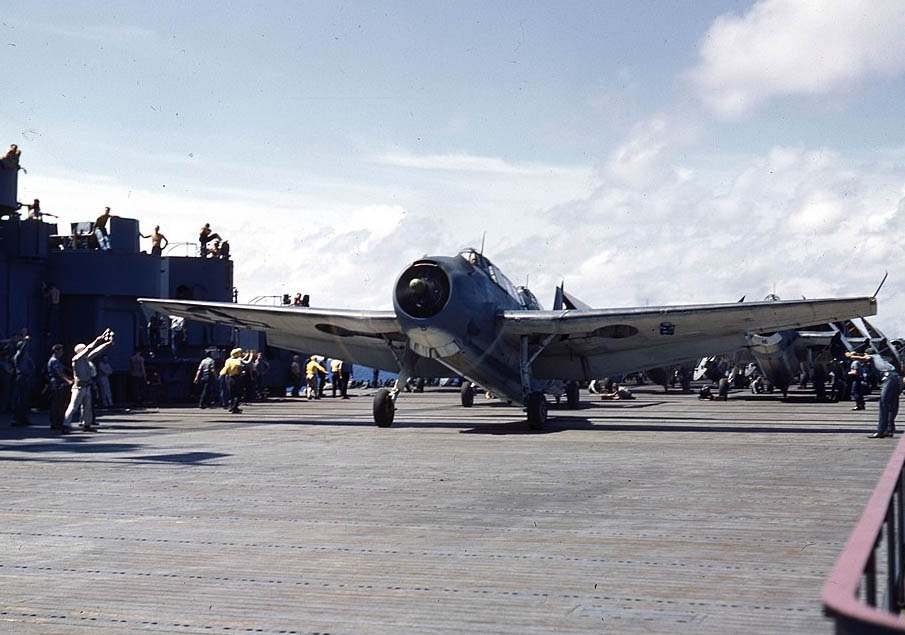
Avenger from VT-5, USS Yorktown
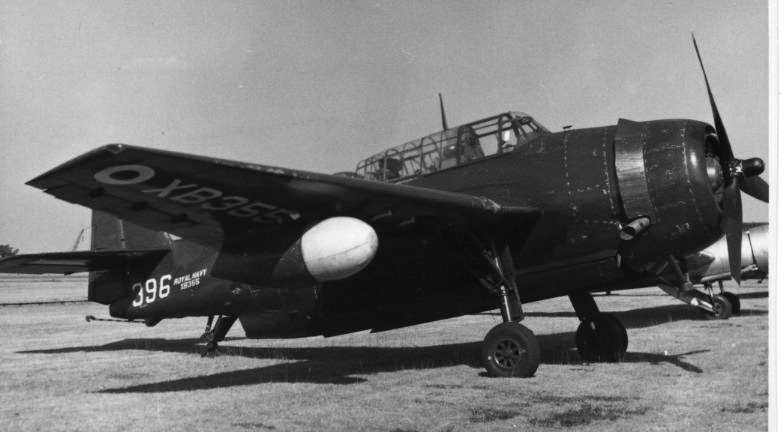
Grumman_Avenger_AS5_XB355_CU396_744_Sq
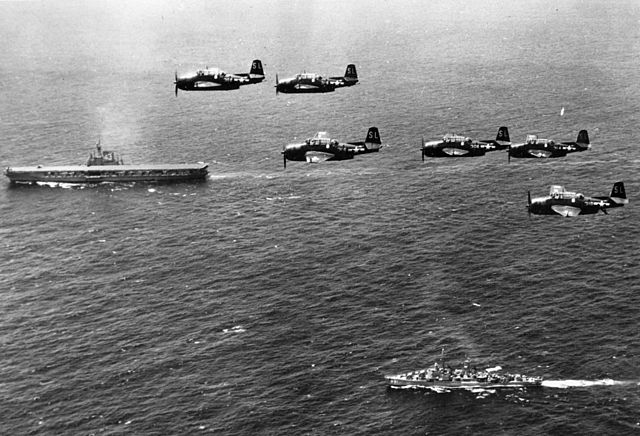
TBM-3Es_VC-22_over_USS_Coral_Sea_CVB-43
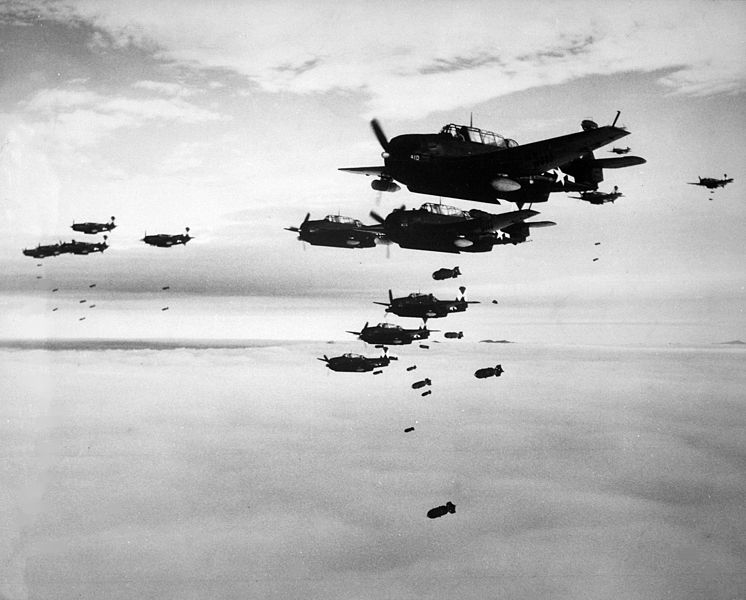
TBMs_and_SB2Cs_dropping_bombs
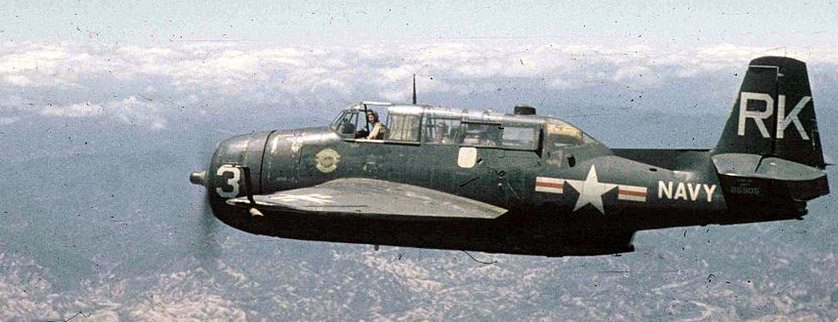
Grumman_TBM-3R_VR-23_over_Korea_1953
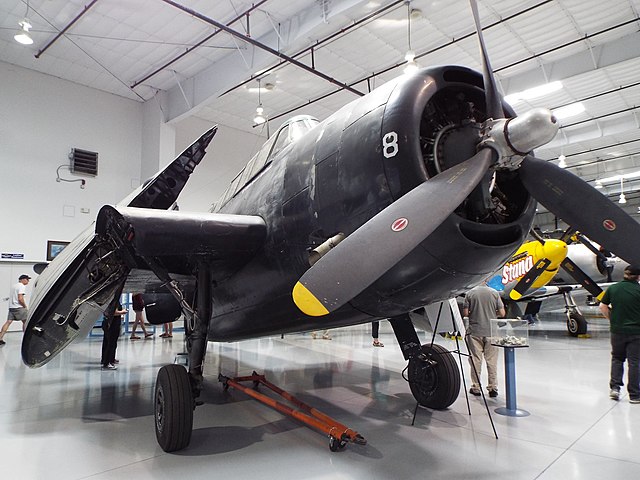
Mesa-Arizona_Commemorative_Air_Force_Museum-Grumman_TBF_Avenger
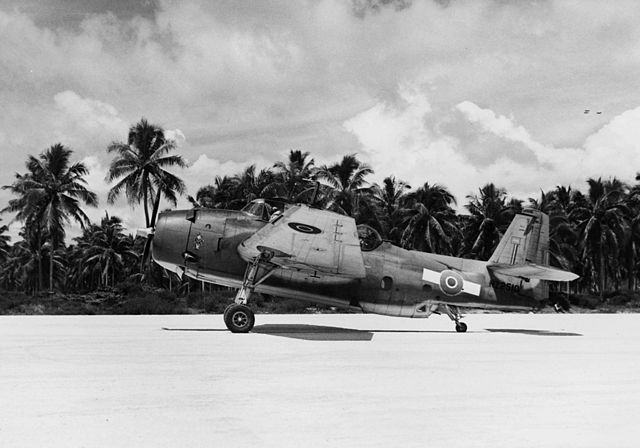
TBF-1C_30_Sqn_RNZAF_Espiritu_Santo_1944
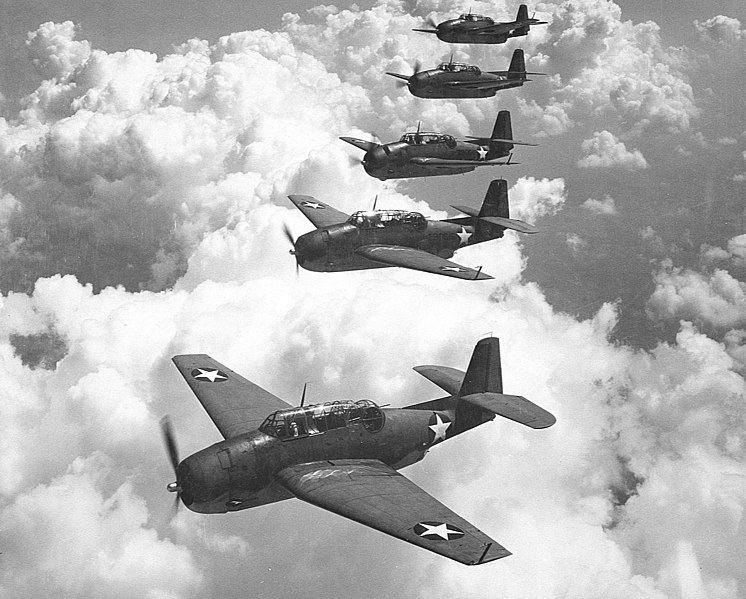
Grumman_TBF-1_Avengers_of_VGS-29_in_flight_over_Norfolk_Virginia_1_September_1942
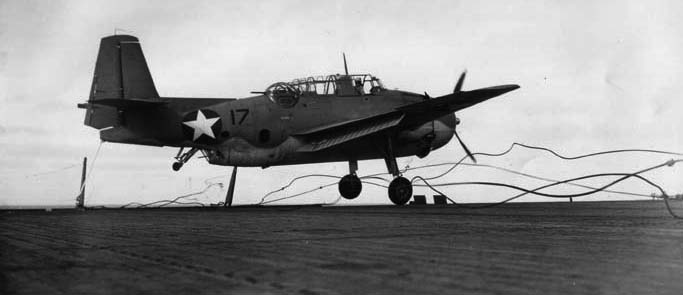
TBF-1_CVE-11_landing_1942_tailhook
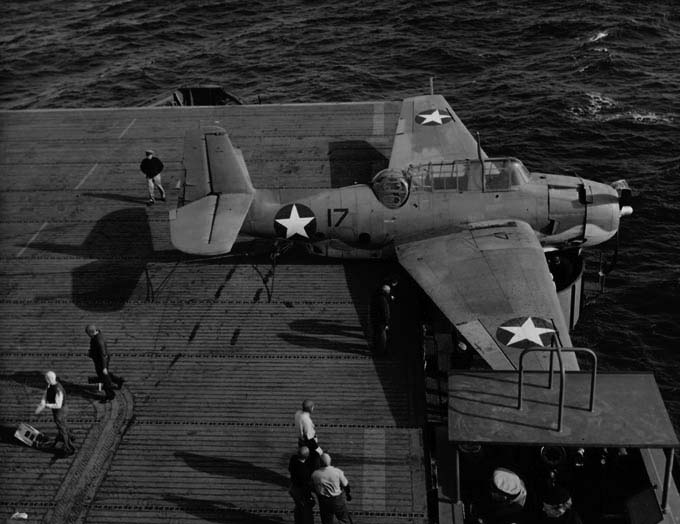
TBF-1_CVE-11_harsh-landing_1942
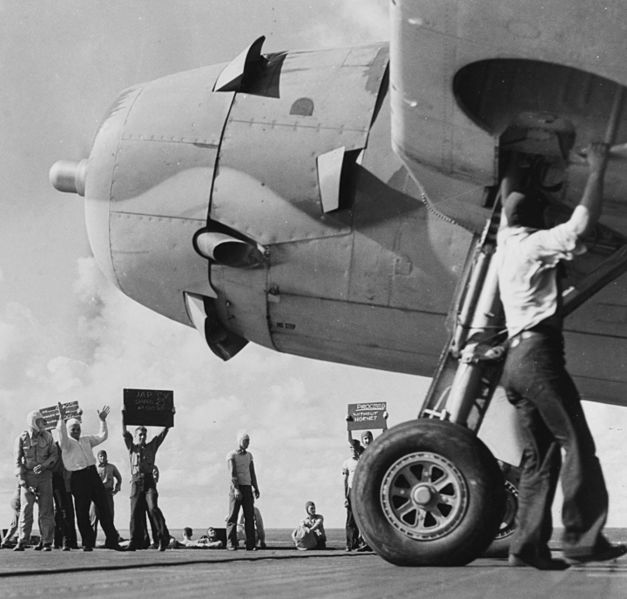
TBF-1_of_VT-10_launches_from_USS_Enterprise_Battle_of_Santa_Cruz_Islands_1942

Grumman_TBF_Avengers_VT-28_aboard_USS_Monterey_CVL-26_launching_June_1944
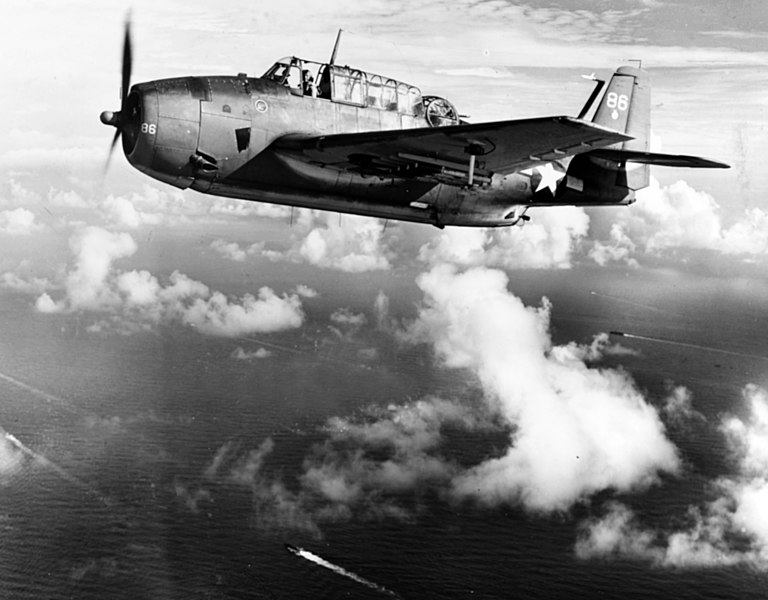
General_Motors_TBM-1C_Avenger_of_VT-2_enroute_to_Saipan_circa_June_1944

TBM_Avenger_catapulted_from_USS_Makin_Island_CVE-93_1945
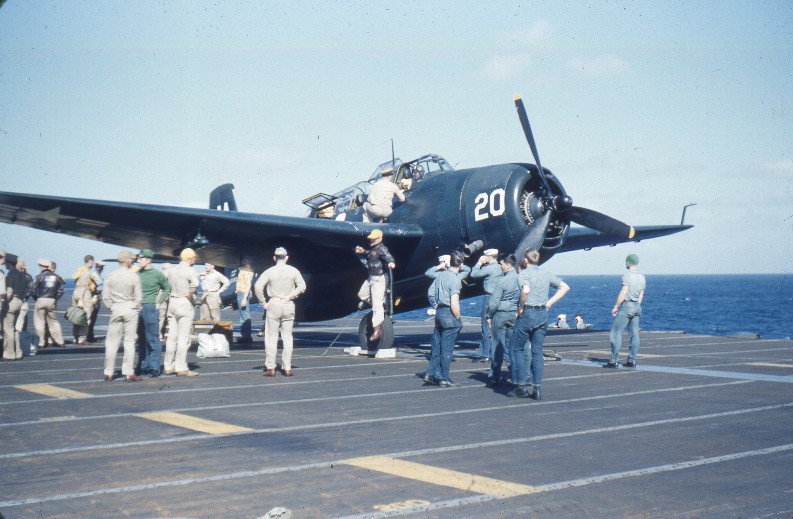
TBM-3R_CV-9_1952
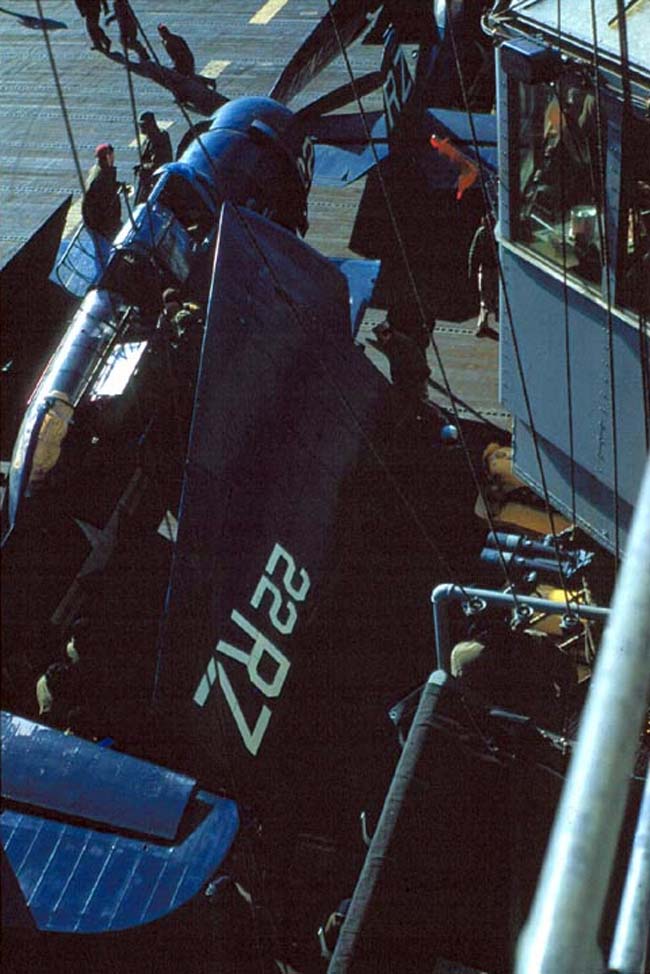
TBM-3R_CV-9_Korea-overhead-view
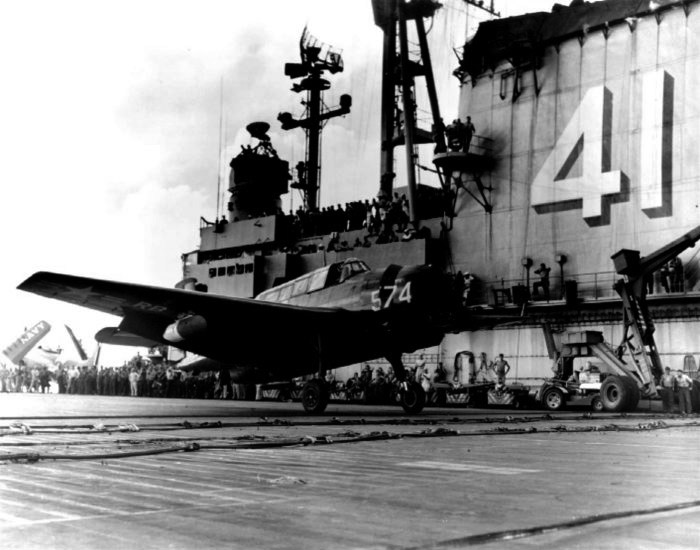
TBM-3R_VR-22_CVB-41_midway_backwards_launch
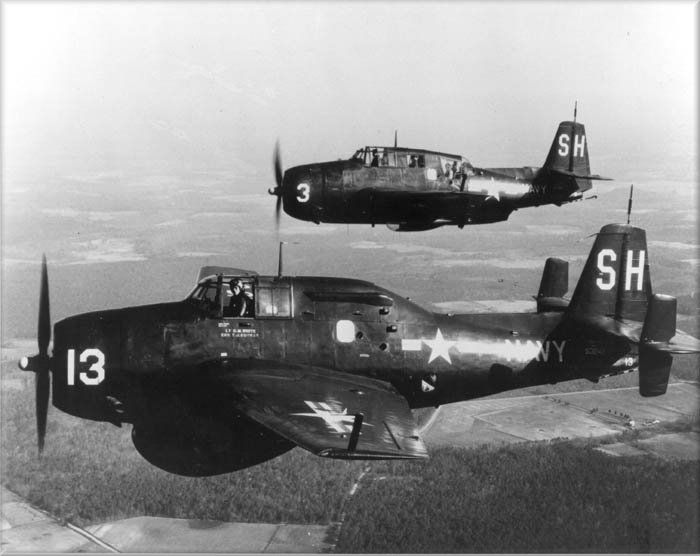
Grumman_TBM-3S2_and_TBM-3W2_Avenger_of_VS-26_in_flight_circa_1953
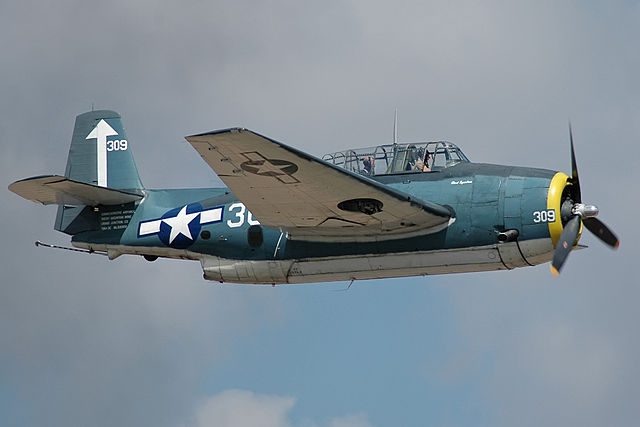
Grumman_TBM-3E_Avenger_today
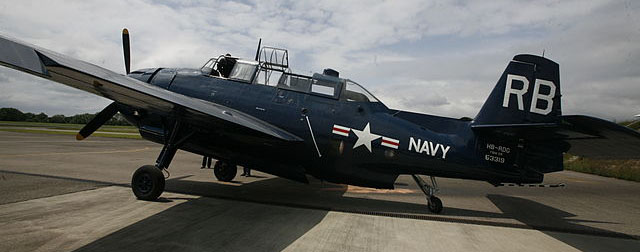
Avenger_mg_3693_today
Src/Read more about the TBF/TBM Avenger:
Books
GRUMMAN (EASTERN) TBF (TBM) AVENGER by Rene J. Fracillon, Profile Publications. THE ILLUSTRATED ENCYCLOPEDIA OF 20TH CENTURY WEAPONS AND WARFARE, edited by Bernard Fitzsimons, 1978 edition. TBM/TBF AVENGER IN ACTION by Charles L. Scrivner, SQUADRON/SIGNAL PUBLICATIONS, 1987. AMERICAN WARPLANES OF WORLD WAR II, edited by David Donald, Aerospace Publishing LTD, 1995. "Grumman TBF/TBM Avenger" by M. Hill Goodspeed, WINGS OF FAME, Volume 13 / 1998, 32:91. Drendel, Lou (2001). TBF/TBM Avenger Walk Around. Carrollton, Texas: Squadron/Signal Publications. Drendel, Lou (1987). "Grumman TBF/TBM Avenger". U.S. Navy Carrier Bombers of World War II. Carrollton, Texas: Squadron/Signal Publications. pp. 89–120. Fletcher, R. G. (1995). Front Line Avenger Squadrons of the FAA. Bury St. Edmunds, Suffolk, UK: R.G. Fletcher.. Francillon, René (1970). Grumman (Eastern) TBF (TBM) Avenger. Aircraft in Profile. Vol. 214. London: Profile Publications. Geelen, Janic (1983). The Topdressers. Auckland: NZ Aviation Press. Hove, Duane (2003). American Warriors: Five Presidents in the Pacific Theater of World War II. Shippensburg, Pennsylvania: Burd Street Press. Jackson, B. R.; Doll, Thomas E. (1970). Grumman TBF/TBM "Avenger". Aero Series. Vol. 21. Fallbrook, California: Aero Publishers. Jackson, B. R.; Doll, Thomas E. (1970). Supplement to Grumman TBF/TBM "Avenger". Fallbrook, California: Aero Publishers. Kinzey, Bert (1997). TBF & TBM Avenger in Detail & Scale. Carrollton, Texas: Squadron/Signal Publications. Pelletier, Alain (1981). Grumman TBF/TBM Avenger (in French). Paris: Editions Ouest-France. Prange, Gordon William; et al. (Goldstein, Donald M.; Dillon, Katherine V.) (1983). Miracle at Midway. New York: Viking. Scrivner, Charles L. (1987). TBF/TBM Avenger in Action. Carrollton, Texas: Squadron/Signal Publications. Skulski, Przemyslaw (1997). Grumman Avenger. Seria Pod Lupa (in Polish). Vol. 5. Wrocław, Poland: Ace Publications. Tillman, Barrett (1979). Avenger at War. London: Ian Allan. Tillman, Barrett (1999). TBF/TBM Avenger Units of World War 2. Botley, UK: Osprey Publishing. Treadwell, Terry C. (2001). Grumman TBF/TBM Avenger. Mount Pleasant, South Carolina: Arcadia Publishing. Wheeler, Barry C. (1992). The Hamlyn Guide to Military Aircraft Markings. London: Chancellor Press.Links
http://wp.scn.ru/en/ww2/b/565/9/1http://www.airvectors.net/avtbm.html
http://www.airvectors.net/avtbm.html
http://aviadejavu.ru/Site/Crafts/Craft26313.htm
https://pacificeagles.net/grumman-tbf-avenger/
https://www.militaryfactory.com/aircraft/detail.php?aircraft_id=300
http://aviadejavu.ru/Site/Arts/Art7879.htm
https://alchetron.com/Grumman-TBF-Avenger
http://www.wings-aviation.ch/32-FAA/2-Aircraft/Grumman-Avenger/bomber.htm
http://avions-de-la-guerre-d-algerie.over-blog.com/article-grumman-tbf-tbm-avenger-52525334.html
https://ww2aircraft.net/forum/threads/help-needed-loadout-on-tbm-3-with-fido-and-radar.49274/
https://www.historynet.com/tough-turkey-why-grummans-tbf-avenger-was-the-ultimate-torpedo-bomber/
https://www.nasflmuseum.com/the-avenger.html
http://www.pilotspost.com/arn0001138
http://www.fiddlersgreen.net/models/aircraft/Grumman-Avenger.html
Videos
https://www.youtube.com/watch?v=gId18EYl2kUOfficial USN video used to train U.S. Navy pilots
https://www.youtube.com/watch?v=AYX9-5eGQ1w
World War Two TBM Avenger pilot Ken Glass shares his story with They Gave It All.
https://www.youtube.com/watch?v=5o2XccN85ZY
Inside the TBM by Military Aviation History
The Models Corner:
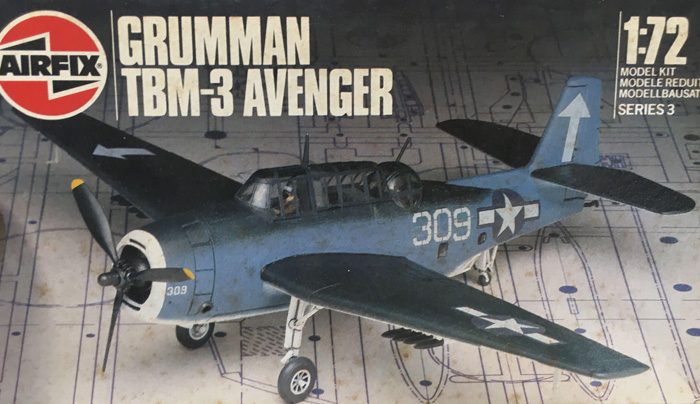
A well covered one. I remembered making the 1/72 airfix kit back in the day. General query on scalemates
The TBF/TBM was covered by almost all kit manufacturers from Japanese ones to US ones, from 1/16, 1/24, 1/32 (Comet, trumpeter and others), 1/36 (Scientific), 1/48 (like Academy, Accurate Miniatures, Ace, Monogram, Hasegawa, HobbyBoss, Lindberg...), 1/50 (Nichimo and Marusan), 1/72 (countless), down to 1/130, 1/144, 1/350 and 1/700 grapples for carrier kits.
- Lohner E (1913)
- Macchi M3 (1916)
- Macchi M5 (1918)
- Ansaldo ISVA (1918)
- Sopwith Baby (1916)
- Short 184 (1916)
- Fairey Campania (1917)
- Sopwith Cuckoo (1917)
- Felixstowe F.2 (1917)
- Friedrichshafen FF 33 (1916)
- Albatros W4 (1916)
- Albatros W8 (1918)
- Hanriot HD.2
- Grigorovitch M5
- IJN Farman MF.7
- IJN Yokosho Type Mo
- Yokosho Rogou Kougata (1917)
- Yokosuka Igo-Ko (1920)
- Curtiss N9 (1916)
- Aeromarine 39
- Vought VE-7
- Douglas DT (1921)
- Boeing FB.5 (1923)
- Boeing F4B (1928)
- Vought O2U/O3U Corsair (1928)
- Blackburn Blackburn (1922)
- Supermarine Seagull (1922)
- Blackburn Ripon (1926)
- Fairey IIIF (1927)
- Fairey Seal (1930)
- LGL-32 C.1 (1927)
- Caspar U1 (1921)
- Dornier Do J Wal (1922)
- Rohrbach R-III (1924)
- Mitsubishi 1MF (1923)
- Mitsubishi B1M (1923)
- Yokosuka E1Y (1923)
- Nakajima A1N (1927)
- Nakajima E2N (1927)
- Mitsubishi B2M (1927)
- Nakajima A4N (1929)
- CANT 18
WW1
✠ K.u.K. Seefliegerkorps:
 Italian Naval Aviation
Italian Naval Aviation
 RNAS
RNAS
 Marineflieger
Marineflieger
 French Naval Aviation
French Naval Aviation
 Russian Naval Aviation
Russian Naval Aviation
 IJN Air Service
IJN Air Service
 USA
USA
Interwar
 Interwar US
Interwar US
 Interwar Britain
Interwar Britain
 Interwar France
Interwar France
 Interwar Germany
Interwar Germany
 Interwar Japan
Interwar Japan
 Interwar Italy
Interwar Italy
- Curtiss SOC seagull (1934)
- Grumman FF (1931)
- Curtiss F11C Goshawk (1932)
- Grumman F2F (1933)
- Grumman F3F (1935)
- Northrop BT-1 (1935)
- Grumman J2F Duck (1936)
- Consolidated PBY Catalina (1935)
- Brewster/NAF SBN-1 (1936)
- Curtiss SBC Helldiver (1936)
- Vought SB2U Vindicator (1936)
- Brewster F2A Buffalo (1937)
- Douglas TBD Devastator (1937)
- Vought Kingfisher (1938)
- Curtiss SO3C Seamew (1939)
- Douglas SBD Dauntless (1939)
- Grumman F4F Wildcat (1940)
- F4U Corsair (NE) (1940)
- Brewster SB2A Buccaneer (1941)
- Grumman TBF/TBM Avenger (1941)
- Consolidated TBY Sea Wolf (1941)
- Grumman F6F Hellcat (1942)
- Curtiss SB2C Helldiver (1942)
- Curtiss SC Seahawk (1944)
- Grumman F8F Bearcat (1944)
- Ryan FR-1 Fireball (1944)
- Douglas AD-1 Skyraider (1945)
Fleet Air Arm
- Fairey Swordfish (1934)
- Blackburn Shark (1934)
- Supermarine Walrus (1936)
- Fairey Seafox (1936)
- Blackburn Skua (1937)
- Short Sunderland (1937)
- Blackburn Roc (1938)
- Fairey Albacore (1940)
- Fairey Fulmar (1940)
- Grumman Martlet (1941)
- Hawker sea Hurricane (1941)
- Brewster Bermuda (1942)
- Fairey Barracuda (1943)
- Fairey Firefly (1943)
- Grumman Tarpon (1943)
- Grumman Gannet (1943)
- Supermarine seafire (1943)
- Blackburn Firebrand (1944)
- Hawker Sea Fury (1944)
IJN aviation
- Aichi D1A "Susie" (1934)
- Mitsubishi A5M "Claude" (1935)
- Nakajima A4N (1935)
- Yokosuka B4Y "Jean" (1935)
- Mitsubishi G3M "Nell" (1935)
- Nakajima E8N "Dave" (1935)
- Kawanishi E7K "Alf" (1935)
- Nakajima B5N "Kate" (1937)
- Kawanishi H6K "Mavis" (1938)
- Aichi D3A "Val" (1940)
- Mitsubishi A6M "zeke" (1940)
- Nakajima E14Y "Glen" (1941)
- Nakajima B6N "Jill" (1941)
- Mitsubishi F1M "pete" (1941)
- Aichi E13A Reisu "Jake" (1941)
- Kawanishi E15K Shiun "Norm" (1941)
- Nakajima C6N Saiun "Myrt" (1942)
- Yokosuka D4Y "Judy" (1942)
- Kyushu Q1W Tokai "Lorna" (1944)
Luftwaffe
- Arado 196 (1937)
- Me109 T (1938)
- Blohm & Voss 138 Seedrache (1940)
Italian Aviation
- Savoia-Marchetti S.55
- IMAM Ro.43/44
- CANT Z.501 Gabbiano
- CANT Z.506 Airone
- CANT Z.508
- CANT Z.511
French Aeronavale
- GL.300 (1926-39)
- Levasseur PL.5 (1927)
- Potez 452 (1935)
- Loire 210 (1936)
- Loire 130 (1937)
- LN 401 (1938)
Soviet Naval Aviation
- Shavrov SH-2 (1928)
- Tupolev TB-1P (1931)
- Beriev MBR-2 (1930)
- Tupolev MR-6 (1933)
- Tupolev MTB-1 (1934)
- Beriev Be-2 (1936)
- Polikarpov I16 naval (1936)
- Tupolev MTB-2 (1937)
- Ilyushine DB-3T/TP (1937)
- Beriev Be-4 (1940)
-
Skoda Š-328V
R-XIII Idro
Fokker C.XI W (1934)
WW2
- De Havilland Sea Vixen
- Hawker Sea Hawk
- Supermarine Scimitar
- Blackburn Buccaneer
- Hawker Sea Harrier
- Douglas A4 Skyhawk
- Grumman F9F Panther
- Vought F8 Crusader
- McDonnell-Douglas F-4 Phantom-II
- North Am. A5 Vigilante
- TU-142
- Yak 38 forger
☢ Cold War
✧ NATO
 Fleet Air Arm
Fleet Air Arm
 US Navy
US Navy
☭ Warsaw Pact
Merch

Seafire Mark 45; HMS Pretoria Castle

Zeros vs its aversaries

Aichi D3A “Val” Junyo

Mitsubishi A5M poster

F4F wildcat

Macchi M5

SBD Dauntless Coral Sea

SBD Dauntless USS Enterprise

SBD-4 CV22